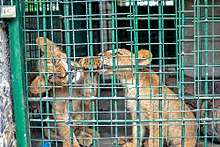African lion
.jpg)
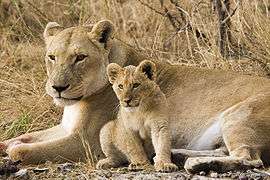
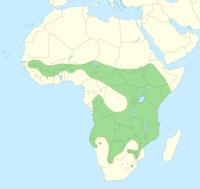
African lions are a genetically diverse population of lions in Africa which are recognised as being divided into two overlapping subspecies as of 2017:[1][2]
- The northern subspecies (Panthera leo leo), comprising lions in the northern portion of Africa, including West Africa, which are related to the Asiatic lion
- The southern subspecies (Panthera leo melanochaita), comprising lions in the southern portion of Africa, including Southeast Africa
The status of lions in the Horn of Africa or northern parts of East Africa is not fully resolved, due to the presence of both subspecies there, and lions in Central Africa have been grouped between the different subspecies by different genetic studies.[2][3] In addition, even the subspecies are not homogeneous,[1] being divided into different clades.[4]
Formerly described subspecies
| Subspecies | Description |
|---|---|
| Barbary lion (P. l. leo), also called the "Atlas lion", "Berber lion" or "North African lion" | Formerly found in the Maghreb, this is the nominate lion subspecies from North Africa. It is extinct in the wild due to excessive hunting; the last, known Barbary lion in the wilderness was killed in Morocco in 1920.[5][6] This was regarded as being one of the largest subspecies,[7] with reported lengths of 3.0–3.3 m (9.8–10.8 ft) and weights of more than 200 kg (440 lb) for males. Besides West and certain Central African lions, it is more closely related to the Asiatic lion than to other African lions.[4] A number of animals in captivity are likely to be Barbary lions,[8] particularly the 90 animals descended from the Moroccan Royal collection at Rabat Zoo.[9] |
| Subspecies | Description | Image |
|---|---|---|
| Senegal lion (P. l. senegalensis), also known as "West African lion" | Found in West Africa.[10][11] It is listed as critically endangered as of 2015.
West Africa: Benin, Burkina Faso, Ghana,[12] Mali, Nigeria, Niger and Senegal | |
| Gambian lion (P. l. gambianus) | Formerly found in the Gambia.[13] |
| Subspecies | Description |
|---|---|
| Cameroon lion (P. l. kamptzi) | Found in Cameroon and the region south of Lake Chad, in Central or Western Africa.[14] |
| Northeast Congo lion (P. l. azandica), or simply the "Congo lion" | Found in northeastern parts of the Congo, adjacent to Uganda.[10]
Central Africa:[15] (Democratic Republic of the Congo) |
| Subspecies | Description |
|---|---|
| Nubian lion (P. l. nubica) | From Nubia in Northeast Africa.[16] |
| Somali lion (P. l. somaliensis syn. P. l. webbiensis | From Somaliland or Somalia, East Africa.[17][18] |
| Masai lion (P. l. massaica) | Found in East Africa, from Ethiopia and Kenya to Tanzania and Mozambique;[11] a local population is known as the "Tsavo lion". |
| Ethiopian lion (P. l. roosevelti syn. P. l. abyssinica), also known as "Abyssinian lion" and "Addis Ababa lion" | 15 captive lions in the Addis Ababa Zoo.[19] Researchers compared the microsatellite variations over ten loci of fifteen lions in captivity with those of six different wild lion populations. They determined that these lions are genetically unique and presumably that "their wild source population is similarly unique." These lions were part of a collection of the late Haile Selassie I of Ethiopia.[20]
Northeast Africa: Ethiopia |
| Kilimanjaro lion (P. l. sabakiensis) | From the northern vicinity of Mount Kilimanjaro in East Africa.[21] |
| Ugandan lion (P. l. nyanzae) | Found in Uganda, East Africa.[14] |
| Sotik lion (P. l. hollisteri), also known as "Hollister's lion" or "Lake Victoria lion" | Found on the eastern bank of Lake Victoria in Kenya, East Africa.[14] |
| Subspecies | Description |
|---|---|
| Cape lion (P. l. melanochaita) | Formerly found from the Cape Province to Natal, South Africa.[22] |
| Katanga lion (P. l. bleyenberghi), also known as the "Angola lion", "Bleyenbergh's lion" or "Southwest African lion" | Found in southwestern Africa. It is among the largest populations of African lions. The type specimen was from Katanga in what in what used to be the Belgian Congo in central Africa.[17][23]
Central Africa: Formerly Katanga (Congo-Kinshasa) Southern Africa: Angola, Botswana, Namibia, Zambia, and Zimbabwe[11] |
| Kruger lion (P. l. krugeri), also known as the "Southeast African lion", "South African lion" or "Transvaal lion" | Found in the Transvaal region of southeast Africa, including Kruger National Park.[11]
Southern Africa: (Botswana, Mozambique, South Africa, Swaziland, Zimbabwe) |
| Kalahari lion (P. l. vernayi) | Found in the Kalahari Region of Southern Africa.[14] |
Northern subspecies
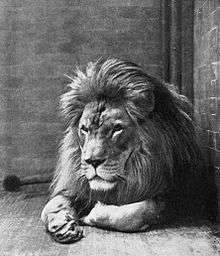
The Northern lion[24][25] (Panthera leo leo) is the nominate subspecies of the lion, which is present in the northern portion of Africa (particularly in West and Central Africa).[2][26] It is regionally extinct in North Africa. In West and Central Africa, lions are restricted to fragmented and isolated populations, most of them declining.[27][28] The West African population is listed as Critically Endangered on the IUCN Red List; this population is isolated and comprises fewer than 250 mature individuals.[29] The Asiatic lion is considered to belong to this subspecies, due to its relationship with North, West and Central African lions.[2]
Results of a phylogeographic study indicate that lion populations in West and Central African range countries are genetically close to populations in India, forming a clade distinct from lion populations in Southern and East Africa.[4] In 2017, the Cat Classification Task Force of the IUCN Cat Specialist Group subsumed lion populations to two subspecies, namely P. l. leo and P. l. melanochaita.[2]
Taxonomic history
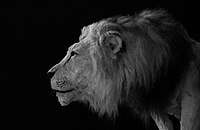
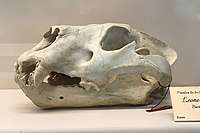
A lion from Constantine, Algeria was the type specimen for the specific name Felis leo used by Linnaeus in 1758.[30] Due to the location of Algeria in Africa, the term "Northern lion" was coined for lions living in the northern portion of the continent in 1865.[24][25] In the 19th and 20th centuries, several lion specimens from Africa were described and proposed as subspecies:
- In 1826, the Austrian zoologist Johann N. Meyer described a lion skin from Persia and named it Felis leo persicus. He also described a lion skin from Senegal under the name F. l. senegalensis.[31]
- In 1843, the French zoologist Henri Marie Ducrotay de Blainville described a male lion from Nubia under the trinomen Felis leo nubicus that had been sent by Antoine Clot from Cairo to Paris and died in the Ménagerie du Jardin des Plantes in 1841.[32]
- In 1843, John Edward Gray described a specimen from Gambia in the British Museum of Natural History as Leo gambianus.[33]
- In 1900, Paul Matschie described a lion skull from northern Cameroon as Felis leo kamptzi.[34]
- In 1924, Joel Asaph Allen proposed the trinomen Leo leo azandicus for an individual that was killed in 1912 in northeastern Belgian Congo as part of a zoological collection comprising 588 carnivore specimens. Allen admitted a close relationship of this lion specimen to Leo leo massaicus from Kenya regarding cranial and dental characteristics, but argued that his type specimen differed in pelage coloration.[18]
In the following decades, there has been much debate among zoologists on the validity of proposed subspecies:
- In 1939, Glover Morrill Allen recognized Felis leo kamptzi and F. l. azandicus as valid taxa among ten lion subspecies.[22][16]
- Three decades later, John Ellerman and Terence Morrison-Scott recognized only two lion subspecies in the Palearctic realm, namely the African (P. l. leo) and Asiatic lions (P. l. persica).[35]
- Some authors considered P. l. nubicus a valid subspecies and synonymous with P. l. massaica.[16][17][36]
- Some authors considered P. l. azandicus synonymous with P. l. massaicus and P. l. somaliensis, and P. l. kamptzi synonymous with P. l. senegalensis.[16][17]
- In 2005, Wallace Christopher Wozencraft recognized P. l. kamptzi, P. l. bleyenberghi and P. l. azandica as valid taxa.[37]
- In 2016, IUCN Red List assessors used P. l. leo for all African populations.[38]
- In 2017, lion populations in North, West and Central Africa and Asia were subsumed to P. l. leo by the Cat Classification Task Force of the IUCN Cat Specialist Group, based on results of genetic research on lion samples.[2]
Genetic research

Since the beginning of the 21st century, several phylogenetic studies were conducted to aid clarifying the taxonomic status of lion samples kept in museums and collected in the wild. Scientists analysed between 32 and 197 lion samples from up to 22 countries. They all agree that the lion species comprises two evolutionary groups, one in the northern and eastern parts of its historical range, and the other in Southern and East Africa that diverged between 245,000 and 50,000 years ago. They assume that tropical rainforest and the East African Rift constituted major barriers between the two groups.[39][40][41][42][4] Based on this assessment, lion taxonomy has been revised as comprising two subspecies:[2]
- P. l. leo in the northern and eastern regions of its historical and contemporary distribution;
- P. l. melanochaita in the contemporary southern and East African range countries.
In a comprehensive study about the evolution of lions, 357 samples of 11 lion populations were examined, including some hybrid lions. The hybrids had descended from lions captured in Angola and Zimbabwe, and apparently West or Central Africa. Results indicated that four lions from Morocco did not exhibit any unique genetic characteristics and shared mitochondrial haplotypes H5 and H6 with lions from West Africa, and together with them were part of a major mtDNA grouping (lineage III) that also included Asiatic samples. This scenario was well in line with theories on lion evolution: lineage III developed in East Africa and traveled north and west in the first wave of lion expansions about 118,000 years ago. It apparently broke up into haplotypes H5 and H6 within Africa, and then into H7 and H8 in West Asia[40]
Western and Central clades
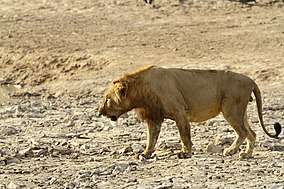
Results of genetic analyses indicate that lions in West Africa and northern parts of Central Africa form distinct clades, which are more closely related to North African and Asiatic lions than to lions in Southern Africa and southern parts of East Africa. Lions from North Africa and India however, do form one single clade.[42] Analysis of phylogenetic data of 194 lion samples from 22 different countries revealed that Central and West African lions form a phylogeographic group that probably diverged about 186,000–128,000 years ago from the melanochaita group in East and Southern Africa.[4]
The West African population is distributed south of the Sahara from Senegal in the west to Nigeria in the east. This population has lost 99% of its former range.[43] It is regionally extinct in Mauritania, Gambia, Guinea-Bissau, Mali, Sierra Leone, Ivory Coast, and Togo, and possibly extinct in Guinea.[29] The largest West African subpopulation of between 246 and 466 individuals survives in the WAP-Complex, a large system of protected areas formed mainly by W, Arli, and Pendjari National Parks in Burkina Faso, Benin, and Niger.[43][44]
The range of the Central African lion clade reaches from the lower Niger river in West Africa to Ethiopia, encompassing Cameroon, Central African Republic, northern parts of the Democratic Republic of the Congo, southern parts of Chad and Sudan, and South Sudan.[4] Some Central African populations permanently inhabit rainforests and clearings in rainforest mixed with savannah grassland.[27] In Cameroon, lions are present in Bénoué National Park, and smaller lion groups also in Waza National Park.[26] Habitat in Waza National Park comprises foremost dry woodland that is partly flooded during the rainy season from July to December. In this protected area, two radio-collared male lions used home ranges of between 428 and 1,054 km2 (165 and 407 sq mi), both inside and outside the park. Three radio-collared females had home ranges of between 352 and 724 km2 (136 and 280 sq mi) and stayed inside the park during most of the survey period.[45] In the Central African Republic, lions are present in Bamingui-Bangoran National Park and Biosphere Reserve, Manovo-Gounda St. Floris and Awakaba National Parks, Aouk Aoukale, Yata Ngaya, Nana Barya and Zemongo Faunal Reserves, and in several hunting reserves of the country.[46] Estimated lion numbers in the country are generally thought to be unreliable.[26][28] Lions in Virunga National Park form a contiguous population with lions in the East African country of Uganda.[26][28] In Chad, lions inhabit Siniaka-Minia Faunal Reserve and Zakouma and Aouk National Parks, but have been extirpated in Manda National Park. Lions may still be present in pastoral rangelands and mountain ranges outside protected areas.[27] In 2004, the lion population in the country was estimated at maximum 225 individuals.[26] The following table shows estimates of lion population sizes between 2002 and 2012:
| Range countries | Area used in km2 | Estimated no. of individuals |
|---|---|---|
| Bénoué National Park complex, Cameroon | 14,682 | 200[47] |
| Waza National Park in Cameroon | 1,452 | 17[48] |
| Central African Republic | 339,418 | about 1,297[46] |
| Garamba National Park and Domaine Chasse Bili Uere, Democratic Republic of the Congo | 115,671 | 175−320[28][27] |
| Southeastern Chad | 133,408 | 400[28] |
| Southwestern Sudan | 331,834 | 375[28] |
| Boma and Gambela National Parks, South Sudan and Ethiopia | 106,941 | 500[28] |
| Omo National Park, Sudan and Ethiopia | 22,483 | 200[28] |
| other protected and non-protected areas, Ethiopia | 70,759 | 96[28] |
| Total | 1,136,648 | 3,260−3,305 |
Contemporary lion distribution and habitat quality in savannahs of West and Central Africa was assessed in 2005, and Lion Conservation Units (LCU) mapped.[49] Educated guesses for size of populations in these LCUs ranged from 3,274 to 3,909 individuals between 2002 and 2012.[27][28]
| Range countries | Lion Conservation Units | Area in km2 |
|---|---|---|
| Senegal, Mali, Guinea-Bissau, Guinea | Niokolo-Koba National Park | 90,384[28] |
| Guinea | National Park of Upper Niger | 613[28] |
| Benin, Burkina Faso, Niger | W-Arly-Pendjari Complex | 29,403[28] |
| Benin | three unprotected areas | 6,833[28] |
| Nigeria | Yankari National Park and Kainji National Park | 6,551[28] |
| Cameroon | Waza and Bénoué National Parks | 16,134[48] |
| Central African Republic | eastern part of the country; Bozoum and Nana Barya Faunal Reserves | 339,481[46] |
| Chad | southeastern part | 133,408[28] |
| Democratic Republic of Congo | Garamba-Bili Uere | 115,671[49] |
| South Sudan, Sudan | 331,834[49] | |
| South Sudan, Ethiopia | Boma-Gambella | 106,941 |
| Ethiopia | South Omo, Nechisar, Bale, Welmel-Genale, Awash National Parks, Ogaden | 93,274[28] |
Southern subspecies
_-_Lioness_Sotik_Plains_1909.png)
_-_Male_Lion_Sotik_Plains_1909.png)
The Southern lion (Panthera leo melanochaita),[24][25] also referred to as the East-Southern African lion[50] or Eastern-Southern African lion,[3] is a subspecies of the lion in Southern and East Africa.[2][51] In this part of Africa, lion populations are regionally extinct in Lesotho, Djibouti and Eritrea.[38] Since the turn of the 21st century, lion populations in intensively managed protected areas in Botswana, Namibia, South Africa and Zimbabwe have increased, but declined in East African range countries.[52] They are threatened by loss of habitat and prey base, killing by local people in retaliation for loss of livestock, and in several countries also by trophy hunting.[38]
The type specimen for P. l. melanochaita was a black-maned lion from the Cape of Good Hope, known as the Cape lion, and consequently, the scientific name was initially meant for it. The lion population in this part of South Africa is extinct.[53]
Taxonomic history
Charles Hamilton Smith described the type specimen for Panthera leo melanochaita in 1842 using the scientific name Felis (Leo) melanochaitus.[54] It was referred to as the "Southern relative" of the North African lion.[24][25] In the 19th and 20th centuries, several naturalists described specimens from Southern and East Africa and proposed subspecies, including:
- Felis leo somaliensis (Noack 1891), based on two lion specimens from Somalia[55]
- Felis leo massaicus (Neumann 1900), based on two lions killed near Kibaya and the Gurui River in Kenya[56]
- Felis leo sabakiensis (Lönnberg 1910), based on two lions from the environs of Mount Kilimanjaro[21]
- Felis leo bleyenberghi (Lönnberg 1914), a male lion from the Katanga Province of Belgian Congo[23]
- Felis leo roosevelti (Heller 1914), a lion from the Ethiopian Highlands presented to Theodore Roosevelt[57]
- Felis leo nyanzae (Heller 1914), a lion skin from Kampala, Uganda[57]
- Leo leo hollisteri (Joel Asaph Allen 1924), a male lion from the area of Lime Springs, Sotik on the eastern shore of Lake Victoria[18]
- Leo leo krugeri (Austin Roberts 1929), an adult male lion from the Sabi Sand Game Reserve named in honour of Paul Kruger[58]
- Leo leo vernayi (Roberts 1948), a male lion from the Kalahari collected by the Vernay-Lang Kalahari Expedition[59]
- Panthera leo webbensies Ludwig Zukowsky 1964, two lions from Somalia, one in the Natural History Museum, Vienna that originated in Webi Shabeelle, the other kept in a German zoo that had been imported from the hinterland of Mogadishu.[60]
Dispute over the validity of these purported subspecies continued among naturalists and curators of natural history museums until the early 21st century.[53][37][22][61][16]
In the 20th century, some authors supported the view of the Cape lion being a distinct subspecies.[58][22][61][62] In 1939, the American zoologist Allen also recognized F. l. bleyenberghi, F. l. krugeri and F. l. vernayi as valid subspecies in Southern Africa, and F. l. hollisteri, F. l. nyanzae and F. l. massaica as valid subspecies in East Africa.[22]
Pocock subordinated lions to the genus Panthera in 1930, when he wrote about Asiatic lions.[63] Ellerman and Morrison-Scott recognized only two lion subspecies in the Palearctic realm, namely the African P. l. leo and the Asiatic P. l. persica.[64] Various authors recognized between seven and 10 African lion subspecies.[16] Others followed the classification proposed by Ellerman and Morrison-Scott, recognizing two subspecies including one in Africa.[65]
In the 1970s, the scientific name P. l. vernayi was considered synonymous with P. l. krugeri.[16] In 1975, Vratislav Mazák hypothesized that the Cape lion evolved geographically isolated from other populations by the Great Escarpment.[53] In the early 21st century, Mazák's hypothesis about a geographically isolated evolution of the Cape lion was challenged. Genetic exchanges between populations in the Cape, Kalahari and Transvaal Province regions and farther east are considered having been possible through a corridor between the Great Escarpment and the Indian ocean.[3][66]
In 2005, the authors of Mammal Species of the World recognized P. l. bleyenberghi and P. l. krugeri, P. l. vernayi P. l. massaica, P. l. hollisteri and P. l. nyanzae as valid taxa.[37] In 2016, IUCN Red List assessors subsumed all African lion populations to P. l. leo.[38] In 2017, the Cat Classification Task Force of the Cat Specialist Group reduced the number of valid lion subspecies in Southern and Southeast Africa to one, namely P. l. melanochaita.[2]
Genetic research
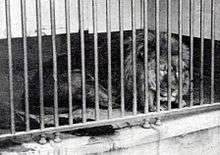
Since the beginning of the 21st century, several phylogenetic studies were conducted to aid clarifying the taxonomic status of lion samples kept in museums and collected in the wild. Scientists analysed between 32 and 197 lion samples from up to 22 countries. Based on the results of a genetic analyses, it appears that the species comprises two main evolutionary groups, one in Southern and East Africa, and the other in the northern and eastern parts of its historical range; these groups diverged about 50,000 years ago.[67] It was assumed that tropical rainforest and the East African Rift constituted major barriers between the two groups.[3][40][68][42][4] Based on this assessment, the species comprises two recognised subspecies:[2]
- P. l. leo in the northern and eastern regions of the species' historical and contemporary distribution
- P. l. melanochaita in Southern and East African range countries.
The two groups were in contact in Ethiopia or northern parts of East Africa.[4] A phylogeographic analysis of 194 lion sequences from 22 countries indicated that East African and Southern African lions form a clade that diverged about 186,000–128,000 years ago from the clade formed by North, West and certain Central African lions. In 9 of 19 lion samples from Ethiopia, haplotypes of the Central African lion group were found, indicating that the Great Rift Valley was not a complete barrier to gene flow; southeastern Ethiopia is considered a genetic admixture zone between Central and East African lions.[4]
Since 2005, several phylogeographic studies were conducted to aid clarifying the taxonomic status of lion samples kept in museums and collected in the wild. Results of a DNA analysis using 26 lion samples from Southern and East Africa indicate that genetic variation between them is low and that two major clades exist: one in southwestern Africa and one in the region from Uganda and Kenya to KwaZulu-Natal. Five lion samples from Kenya's Tsavo East National Park showed identical haplotypes as three lion samples from the Transvaal region in South Africa.[69] Results of phylogeographic studies support the notion of lions in Southern Africa being genetically close, but distinct from populations in West and North Africa and Asia.[40][42] Based on the analysis of samples from 357 lions from 10 countries, it is thought that lions migrated from Southern Africa to East Africa during the Pleistocene and Holocene eras.[40]
A phenotypic and DNA analysis was conducted using samples from 15 captive lions in the Addis Ababa Zoo and from six wild lion populations. Results showed that the captive lions were genetically similar to wild lions from Cameroon and Chad, but with little signs of inbreeding.[20]
Lions samples from Gabon's Batéké Plateau National Park and Odzala-Kokoua National Park in Republic of the Congo were found to be related to the Southern lion clade.[3]
Northeastern clade
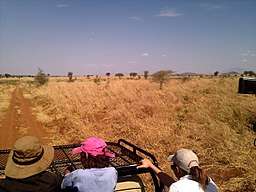
The range of the Northeastern clade outside the admixture zone is confined to Somalia and northern and central Kenya.[4] Already in the 1980s, the lion population in Somalia had greatly declined due to poaching and was restricted to woodlands in the southern part of the country.[70] In northern Kenya, lions had been observed near Kavirondo, near Lake Manyara and in the Tanga Region in the late 19th century.[56] By the 21st century, lion populations in northern Kenya have been fragmented.[71]
| Range countries | Area used in km2 | Estimated no. of individuals |
|---|---|---|
| Laikipia-Samburu complex in Kenya | 35,511 | 271[28] |
| Meru in Kenya | 7,365 | 40[28] |
| Arawale complex in Kenya and Somalia | 22,540 | 750[28] |
| Arboweerow-Alafuuto in Somalia | 24,527 | 175[28] |
| Total | XXX | XXX |
Southern / Eastern clade
.jpg)
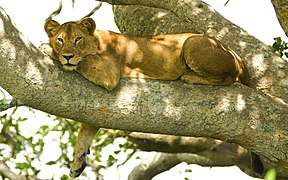
This is the clade with the largest remaining populations. The range of this clade extends from southern Kenya, southern Uganda and the Virunga area in the Democratic Republic of the Congo southward to the Cape of Good Hope, excluding only the western parts of Southern Africa.[4]
The following complexes are considered lion strongholds of the Southern/Eastern clade:[28]
- Ruaha National Park cum Rungwa Game Reserve
- Serengeti National Park cum Maasai Mara
- Tsavo East National Park, Tsavo West National Park with Mkomazi National Park
- Selous Game Reserve
- North Luangwa National Park and South Luangwa National Park
- Kgalagadi Transfrontier Park
- Niassa Reserve
- Zambezi National Park with adjacent protected areas along Zambezi River in Zambia and Mozambique
Lions in Queen Elizabeth National Park, which form a contiguous population with lions in Virunga National Park in the northeastern part of the Democratic Republic of the Congo,[28][72][26] do belong to the Southern Eastern clade.[4] In 2010, the lion population in Uganda was estimated at 408 ± 46 individuals in three protected areas including Queen Elizabeth, Murchison Falls and Kidepo Valley National Parks. Other protected areas in the country probably host less than 10 lions.[73] As of 2006, there were an estimated 675 lions in the Tsavo area, out of the 2,000 total in Kenya.[74] Between 2004 and 2013, lion guardians around Amboseli National Park identified 65 lions in an area of 3,684 km2 (1,422 sq mi).[71]
A small population is present in Rwanda's Akagera National Park, estimated at 35 individuals at most in 2004.[26]
The population in South Africa's former Natal and Cape Provinces is locally extinct since the mid 19th century.[75] The last lions south of the Orange River were sighted between 1850 and 1858.[53] Between 2000 and 2004, 34 lions were reintroduced to eight protected areas in the Eastern Cape Province, including Addo Elephant National Park.
| Range countries | Area used in km2 | Estimated no. of individuals |
|---|---|---|
| Virunga and Queen Elizabeth National Park in CAR and Uganda | 5,583 | 210[28] |
| Lake Mburo in Uganda | 373 | 3[28] |
| Luama Hunting Reserve in DRC | 5,197 | <50[28] |
| Itombwe Massif in DRC | 3,244 | <50[28] |
| North West Tansania | 4,703 | 105[28] |
| Ruaha-Rungwa in Tanzania | 195,993 | 3,779[28] |
| Mpanga Kipengere in Tanzania | 958 | 14[28] |
| Swaga Swaga in Tanzania | 7,242 | 102[28] |
| Serengeti-Mara in Tanzania and Kenya | 35,852 | 3,673[28] |
| Nairobi in Kenya | 830 | <30[28] |
| Tsavo-Mkomazi in Kenya and Tanzania | 39,216 | 880[28] |
| Tarangire In Tanzania | 28,771 | 731[28] |
| Wami Mbiki-Saadani in Tanzania | 8,787 | 136[28] |
| Selous in Tanzania | 138,035 | 7,644[28] |
| Niassa in Mozambique, Tanzania | 177,559 | 1,573[28] |
| Liuwa Plains in Zambia | 3,866 | 4[28] |
| Kafue in Zambia | 58,898 | 386[28] |
| Nsumbu in Zambia | 5,650 | <50[28] |
| Luangwa National Park in Zambia | 72,992 | 574[28] |
| Kasungu in Malawi | 2,341 | 4[28] |
| Nkhotakota in Malawi | 1,846 | 18[28] |
| Kgalagadi in South Africa and Botswana | 163,329 | 800[28] |
| Mid-Zambezi in Mozambique, Zambia, Zimbabwe and Mozambique | 64,672 | 755[28] |
| Tete South of Cahora Bassa, Gile and Gorongosa-Marromeu in Mozambique | 13,612, 22,322, 46,781 | 59, 45, 229[28] |
Limpopo admixture zone
_(30941994012).jpg)
The area of the Kruger National Park, which is part of the Great Limpopo Transfrontier Park, is an admixture zone between the Southern-Eastern and the Southwestern clade. This area is a lion stronghold with about 2,300 lions.[28]
Southwestern clade
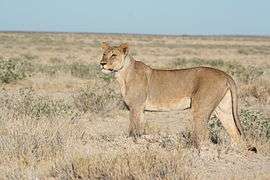
The only stronghold of the Southwestern clade is in the western parts of the Kavango–Zambezi Transfrontier Conservation Area, including Okavango Delta and Hwange National Park[76][28] Another important reserve for this clade is the Etosha National Park.[28] Lions are considered regionally extinct in the southwestern part of the Democratic Republic of the Congo.[38][5]
In Gabon, the presence of lions in Batéké Plateau National Park was doubtful in 2010.[77] In 2015, a camera trap recorded a single male lion in this national park.[78] Continued camera trapping in the area for more than one year recorded the same lion repeatedly. Its hair samples were collected for phylogenetic analysis and compared with tissue samples of lions from Gabon and Republic of the Congo that were killed in the 20th century. Results indicate that this individual is closely related to the ancestral lion population of the area, and that its DNA shows a typical Southern lion haplotype. It is considered possible that this lion dispersed to the area from Namibia or Botswana.[3]
In the Republic of the Congo, the Odzala-Kokoua National Park was considered a lion stronghold in the 1990s. By 2014, no lions were recorded in the protected area, so that now, the species is considered locally extinct in the country.[79]
| Range countries | Area used in km2 | Estimated no. of individuals |
|---|---|---|
| Southwestern clade | ||
| Kissama-Mumbondo in Angola | 4,593 | <10[28] |
| Bocoio-Camucuio in Angola | 22,005 | 55[28] |
| SE Angola | 386,962 | 1,905[28] |
| Sioma Ngwezi in Zambia | 4,155 | <50[28] |
| Etosha-Kunene in Namibia | 123,800 | 455[28] |
| Khaudum-Caprivi in Namibia | 92,372 | 150[28] |
| Xaixai in Botswana | 12,484 | 75[28] |
| Okavango-Hwange | 99,552 | 2,300[28] |
| Greater Mapungubwe in Botswana, South Africa and Zimbabwe | 5,158 | 25[28] |
| Bubye in Zimbabwe | 4,875 | 200[28] |
| Total | XXX | XXX |
Northeast African population
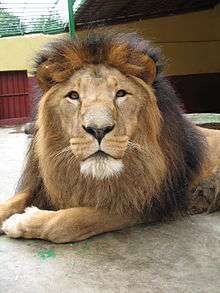
In Northeast Africa, lions occur in Ethiopia, Somalia, South Sudan and Sudan, but are regionally extinct in Djibouti and Eritrea.[38] The results of genetic tests published in 2016 indicated that lions in the region where North Africa overlaps with East Africa (including northern Kenya and possibly northern Uganda), are genetically mixed[4] between the Central African (P. l. leo) and East-Southern African lions (P. l. melanochaita). As a consequence, the taxonomic status of lions in the Horn of Africa was not resolved by the Cat Specialist Group.[2] Subpopulations were referred to by trinomina such as Panthera leo nubica, Panthera leo roosevelti and Panthera leo somaliensis, and names such as "Abyssinian lion", "Egyptian lion", "Nubian lion", "Somali lion" and "Sudan lion",[80] depending on the locality of occurrence.[17][14][81]
Genetic analyses and taxonomic history
_(18243500220).jpg)
_(18433145331).jpg)
In the 19th century, a number of subspecies were described for lions in Northeast Africa. For example, zoological specimens from Nubia and Somalia were described or proposed by zoologists under the trinomina Felis leo nubicus[32] and Felis leo somaliensis.[55] In later centuries, these trinomina were alternatively considered to be synonymous with the scientific names of the North[22][37] and East African lions.[17][81]
A test done in 2012 on 15 lions at Addis Ababa Zoo and lions from 6 wild populations demonstrated that the captive lions were genetically different to wild lions in other parts of East Africa, but similar to wild lions from Cameroon and Chad.[20][19]
Among six samples from captive lions which were of Ethiopian origin, five samples clustered with other East African samples, but one clustered with Sahelian samples.[42] For a subsequent study, also eight additional samples from wild lions from the Ethiopian Highlands were included in a subsequent analysis. Three of them clustered with the Central African lion clade, and five with other East African samples. The Ethiopian Highlands east and west of the Rift Valley was therefore assumed by scientists to have been a zone of genetic admixture between the two phylogeographic groups.[4]
Results of a phylogeographic analysis using samples from African and Asiatic lions was published in 2006. One of the African samples was a vertebra from the National Museum of Natural History (France) that originated in the Nubian part of Sudan. In terms of mitochondrial DNA, it grouped with lion skull samples from the Central African Republic, Ethiopia and the northern part of the Democratic Republic of the Congo.[3]
A phylogeographic analysis of Pleistocene cave lions, the results of which were published in 2009, revealed that a lion sample from Sudan was distinct from lion samples that originated in the northeastern part of Congo-Kinshasa.[84]
In 2016, analysis of the genomes of lions showed that there had been a basal split between lions in northern and southern parts of Africa. Lions in northern Central Africa belong to the northern clade, and those in Southeast Africa belonged to the southern clade. Lions samples from Ethiopia were shown to be related to both the South-East African and Central African groups, indicating an overlap between these groups there.[4]
In 2017, the Cat Classification Taskforce of the Cat Specialist Group subsumed lion populations in West, Central and North Africa to P. l. leo, and those in East Africa to P. l. melanochaita. At the same time, it was stated that these two subspecies overlap in Ethiopia.[2]
One of the largest lion populations in Ethiopia is found in Gambella. According to genetic research, this population, which is contigous with populations in Sudan, does not belong to the Southern subspecies but to the Northern lion. The same is probably true for the populations in northern Ethiopia,[4] where, a group of lions was recorded in 2016 in Alatash National Park close to the international border with Sudan.[85][86][87]
Other parts of Ethiopia, which still have lions fall into the admixture zone. These are Omo and Bale Mountains National Parks, the ara around the Chew Bahir and Turkana lakes, and the Webi Shabeelle area.[26] In 2009, a small group of less than 23 lions were estimated in Nechisar National Park located in the Great Rift Valley. This small protected area in the Ethiopian Highlands is encroached by local people and their livestock.[88]
Lions of northern Uganda have not been analysed genetically,[4] and might belong to the Northern subspecies. In northern Uganda, lions are present in Kidepo Valley and Murchison Falls National Parks.[26][28]
Central African population
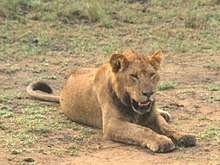
The Central African lion[90] is a population of lions in Central Africa that has been grouped under the northern subspecies (Panthera leo leo), but was also found to be related to the southern subspecies[3][4] (Panthera leo melanochaita),[2][38] depending on the subpopulation, and is fragmented into small and isolated groups since the 1950s.[27][26]
Distribution and habitat
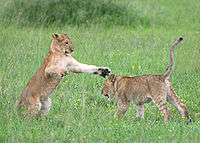
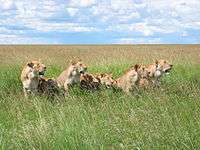
In Northeast Africa, lions may inhabit a variety of habitats, excepting dense forests. For example, in Sudan, they were recorded on the banks of the Blue and White Niles, and far away into desert areas.[80]
Currently, not much is known about the distribution and sizes of populations in Sudan]] and South Sudan. In the 1980s, lions were reported in Southern Kordofan and Southern Darfur provinces, located west of the Nile River.[27][28] In 2016, lions were discovered in Ethiopia's Alatash National Park, which is adjacent to Sudan's Dinder National Park.[85][86][87]
The southern lion was originally found from Ethiopia and Uganda in the north to the Cape of Good Hope in the south. Supported by genetic research, the border between the Southern and Northern subspecies runs through Ethiopia. Southeastern Ethiopia is considered a genetic admixture zone between the two groups. Within the Southern lion, genetic research identified three clades. These are the Northeastern, East-Southern and Southwestern subclade.[4]
In East and Southern Africa, the population of lions declined in:
- Somalia since the early 20th century.[91]
- Uganda to near extinction in the 20th century.[92]
- Kenya in the 1990s due to poisoning of lions and poaching of lion prey species.[27]
- Rwanda and Tanzania due to killing of lions during the Rwandan Civil War and ensuing refugee crisis in the 1990s.[27]
- Malawi and Zambia due to illegal hunting of prey species in protected areas.[27]
- Botswana due to intensive hunting and conversion of natural habitats for settlements since the early 19th century.[93]
- Namibia due to massive killing of lions by farmers since at least the 1970s.[94]
- South Africa since the early 19th century in the Natal and Cape Provinces south of the Orange River, where the Cape lion population was eradicated by 1860.[53] A few decades later, lions in the Highveld north of the Orange River were also eradicated.[95] In the Transvaal, lions occurred historically in the Highveld as well, but were restricted to eastern Transvaal's Bushveld by the 1970s.[96]
Contemporary lion distribution and habitat quality in East and Southern Africa was assessed in 2005, and Lion Conservation Units (LCU) mapped.[50] Between 2002 and 2012, educated guesses for size of populations in these LCUs ranged from 33,967 to 32,000 individuals.[27][28]
| Range countries | Lion Conservation Units | Area in km2 |
|---|---|---|
| Democratic Republic of Congo | Massif D'itombwe, Luama | 8,441[50] |
| Democratic Republic of Congo, Uganda | Queen Elizabeth-Virunga | 5,583[97] |
| Uganda | Toro-Semulik, Lake Mburo, Murchison Falls | 4,800[98] |
| Somalia | Arboweerow-Alafuuto | 24,527[50] |
| Somalia, Kenya | Bushbush-Arawale | 22,540[50] |
| Kenya | Laikipia-Samburu, Meru and Nairobi National Parks | 43,706[28] |
| Kenya, Tanzania | Serengeti-Mara and Tsavo-Mkomazi | 75,068[46] |
| Tanzania | Dar-Biharamulo, Ruaha-Rungwa, Mpanga-Kipengere, Tarangire, Wami Mbiki-Saadani, Selous | 384,489[46] |
| Tanzania, Mozambique | Niassa | 177,559[99] |
| Mozambique | Cahora Bassa, Gilé, Gorongosa-Marromeu | 82,715[99] |
| Mozambique, Zambia | Middle Zambezi | 64,672[99] |
| Mozambique, South Africa | Great Limpopo Transfrontier Park | 150,347[99] |
| Zambia | Liuwa Plains, Sioma Ngwezi, Kafue Sumbu Complex | 72,569[28] |
| Zambia, Malawi | North-South Luangwa | 72,992[28] |
| Malawi | Kasungu, Nkhotakota | 4,187[28] |
| Zimbabwe | Mapungubwe, Bubye | 10,033[28] |
| Botswana, Zimbabwe | Okavango-Hwange | 99,552[28] |
| Botswana | Xaixai | 12,484[50] |
| Botswana, South Africa | Kgalagadi | 163,329[28] |
| Angola | Kissama-Mumbondo, Bocoio-Camacuio, Alto Zambeze | 393,760[50] |
| Angola, Namibia | Etosha-Kunene | 123,800[50] |
| Namibia | Khaudum-Caprivi | 92,372[50] |
The LCUs Ruaha-Rungwa, Serengeti-Mara, Tsavo-Mkomazi and Selous in East Africa, as well as Luangwa, Kgalagadi, Okavango-Hwange, Mid-Zambezi, Niassa and Greater Limpopo in Southern Africa are currently considered as lion strongholds. These LCUs host more than 500 individuals each, and the population trend is stable there.[28]
Today, the northern subspecies occurs in West and Central Africa.[2] It is regionally extinct in Gambia, Mauritania, Sierra Leone, the Western Sahara, Morocco, Algeria, Tunisia, Libya and Egypt. Its range has declined to the:[38]
- West African lion population surviving in a few protected areas of Senegal, Burkina Faso, Niger, Benin and Nigeria.[29] This population is fragmented and isolated, comprising fewer than 250 mature individuals.[29] The Central African population is threatened by loss of habitat and prey base and trophy hunting.[27][48][47]
- Central African lion population surviving in protected areas of Cameroon, the Central African Republic, northern parts of the Democratic Republic of the Congo, southern parts of Chad and South Sudan and in Ethiopia.[28][47][48][46]
Former range
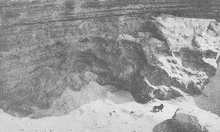
Historically, the northern subspecies' range encompassed North Africa.[2] In these regions, lion populations occurred in the Sahel, mountain ranges of the Sahara, Barbary Coast, Maghreb,[27][16][6] and the eastern Mediterranean Basin.[95][14] North African populations declined since the mid-19th century and were eradicated by the early 1960s.[100][6]
Characteristics
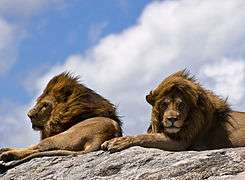
.jpg)

The lion's fur varies in colour from light buff to dark brown. It has rounded ears and a black tail tuft. Average head-to-body length of male lions is 2.47–2.84 m (8.1–9.3 ft) with a weight of 148.2–190.9 kg (327–421 lb). Females are smaller and less heavy.[95]
A few lion specimens from West Africa obtained by museums have been described as having shorter manes than lions from other African regions.[16] In general, the West African lion is similar in general appearance and size as lions in other parts of Africa and Asia.[17]
Zoological specimens range in colour from light to dark tawny. Male skins have short manes, light manes, dark manes or long manes.[101] Taxonomists recognised that neither skin nor mane colour and length of lions can be adduced as distinct subspecific characteristics. Then they turned to measuring and comparing lion skulls and found that skull length of Barbary and Indian lion samples does not differ significantly, ranging from 280–311.7 mm (11.02–12.27 in) in females and 338–362 mm (13.3–14.3 in) in males.[101][16]
The lion's fur varies in colour from light buff to dark brown. It has rounded ears and a black tail tuft. Average head-to-body length of male lions is 2.47–2.84 m (97–112 in) with a weight of 148.2–190.9 kg (327–421 lb). Females are smaller and less heavy.[95]
The Cape lion had a black mane extending beyond the shoulders and under the belly.[54] Yet, black-maned lions also occur in the Kalahari and eastern Okavango Delta alongside those with a normal tawny colour.[102] Until the late 20th century, mane colour and size was thought to be a distinct subspecific characteristic.[16][53]
In 2002, research in Serengeti National Park revealed that mane darkens with age; its colour and size are influenced by environmental factors like temperature and climate, but also by individual testosterone production, sexual maturity and genetic precondition. Mane length apparently signals fighting success in male–male relationships.[103]
Male lions killed in East Africa were less heavy than lions killed by hunters in Southern Africa.[104] The captive male lions at Addis Ababa Zoo have darker manes and smaller bodies than those of wild populations.[20]
White lions have occasionally been encountered in and around Kruger National Park and the adjacent Timbavati Private Game Reserve in South Africa. Their whitish fur is a rare morph caused by a double recessive allele.[105]
Manes
In the 19th and 20th centuries, lion type specimen were described on the basis of mane size and colour.[106] Male East African lions are known for a great range of mane types. Mane development is related to age: older males have more extensive manes than younger ones; manes continue to grow up to the age of four to five years, long after lions have become sexually mature. Males living in the highlands above 800 m (2,600 ft) elevation develop heavier manes than lions in the more humid and warmer lowlands of eastern and northern Kenya. The latter have thinner manes, or are even completely maneless.[107] Hence, lion manes reflect ambient temperature. The mane colour is also influenced by nutrition and testosterone. Its length is an indicator for age and fighting ability of the lion.[103]
A male lion specimen from Somalia had a short mane.[16] Male lions from the Ethiopian highlands had dark and heavy manes with black tips that extended over the whole throat and chest to the forelegs and behind the shoulders.[57] A few lions observed in the environs of Mount Kilimanjaro had tawny to sandy coloured manes as well.[23] Two male lions observed in the border region between Kenya and Tanzania had moderate tufts of hair on the knee joint, and their manes appeared brushed backwards. They were less cobby with longer legs and less curved backs than lions from other African range countries.[56] Mane colour of males in Kenya vary between tawny, isabelline and light reddish yellow.[106] Tsavo male lions generally do not have a mane, though colouration and thickness vary. There are several hypotheses as to the reasons. One is that mane development is closely tied to climate because its presence significantly reduces heat loss.[108] An alternative explanation is that manelessness is an adaptation to the thorny vegetation of the Tsavo area in which a mane might hinder hunting. Tsavo males may have heightened levels of testosterone, which could also explain their reputation for aggression.[109]
The weak or absent mane of Tsavo lions is a feature which was characteristic also for the extinct lions of ancient Egypt and Nubia. Adult lion males in Egyptian art are usually depicted without a mane, but with a ruff around the neck.[110]
White lion
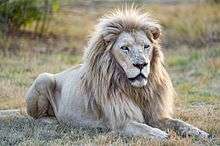
The white lion is a rare morph of the South African lion with a genetic condition called leucism, which is caused by a double recessive allele. It has normal pigmentation in eyes and skin. White individuals have been occasionally encountered only in and around Kruger National Park and the adjacent Timbavati Private Game Reserve in eastern South Africa. They were removed from the wild in the 1970s, thus decreasing the white lion gene pool. Nevertheless, 17 births have been recorded in five different prides between 2007 and 2015.[105] White lions are selected for breeding in captivity.[111] Reportedly, they have been bred in camps in South Africa for use as trophies to be killed during canned hunts.[112]
Records
An exceptionally heavy male near Mount Kenya weighed 272 kg (600 lb).[5] The largest East African lion reportedly measured 3.33 m (10.9 ft).[95]
In 1936, a man-eating South African lion shot by Lennox Anderson, outside Hectorspruit in Eastern Transvaal, weighed about 313 kg (690 lb), and was considered to be the heaviest wild lion. The longest wild lion reportedly was a male shot near Mucusso in southern Angola in 1973.[113][114]
Behaviour and ecology

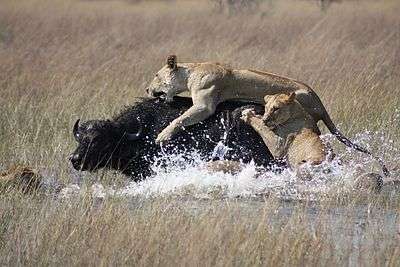
The lion is a social cat, living in groups of related individuals with their offspring. Such a family group is called a 'pride'. The average pride consists of around 15 lions, including several adult females and up to four males and their cubs of both sexes. Large prides, consisting of up to 30 individuals, have also been observed. Male lion groups are called a coalition. Membership only changes with the births and deaths of female lions. Male cubs are excluded from their maternal pride when they reach maturity at around 2–3 years of age.[115] The sole known exception of this pattern is the Tsavo lion pride, which always has just one adult male.[116]
Male lions spend years in a nomadic phase before gaining residence in a pride.[117] In 1966, a program was started to monitor lions in Serengeti National Park.[115] Between 1966 and 1972, two observed prides had between seven and ten females each. On average, females had litters once in 23 months.[118] Two or three cubs comprised the litters, and only twelve managed to grow to the age of two, out of 87 cubs born until 1970. Cubs died due to starvation in months Factors that contributed to the deaths of cubs were starvation, when large prey was not available, or when new males took over the prides. Between 1974 and 2015, prides were monitored again, and until 2012, 471 coalitions comprising 796 male lions entered a study area of 2,000 km2 (770 sq mi). Of these, 35 coalitions included male lions that were born in this place but had left and returned after being absent for about two years. Nomadic coalitions gain residency at between 3.5 and 7.3 years of age.[119] Results of a 10-year long survey on 50 radio-collared lions in the Kavango–Zambezi Transfrontier Conservation Area show that adult lions preferred grassland and shrubland habitat, but avoided woodlands and areas with high human density; by contrast, subadult dispersing male lions avoided grasslands and shrublands, but moved in human-dominated areas to a larger extent. Hence, dispersing lions are more vulnerable to coming into conflict with humans than adult lions.[120]
Lions usually hunt in groups and prey foremost on ungulates such as wildebeest, zebra, African buffalo, gemsbok and giraffe.[121] In the Serengeti National Park, lions were observed to also scavenge on carrion when the opportunity arises. They scavenged animals that were killed by other predators, or died from natural causes. They kept a constant lookout for circling vultures, apparently being aware that vultures indicate a dead animal. Sympatric predators include the leopard, cheetah, hyena and African wild dog.[115][117][122] The lion and spotted hyena occupy a similar ecological niche, and where they coexist, they compete for prey and carrion; a review of data across several studies indicates a dietary overlap of 58.6%. Lions typically ignore spotted hyenas unless the lions are on a kill or are being harassed by the hyenas, while the latter tend to visibly react to the presence of lions, with or without the presence of food.[123]
Lions predominantly hunt large ungulates like zebra, warthog, blue wildebeest, impala, gemsbok, Thomson's gazelle, kob, waterbuck, kudu, giraffe and Cape buffalo. Their prey is usually in the range of 40.0 to 270.0 kg (88.2 to 595.2 pounds).[121] Predation on adult African bush elephants has been observed in Chobe National Park, Botswana.[124][125]
Lions in Botswana's Okavango Delta have learned to swim in the delta's swamps. They hunt large prey like buffalo,[126] and occasionally also African elephants when smaller prey is scarce.[127]
In Benin's Pendjari National Park, groups of lions range from 1–8 individuals. Outside the national park, groups are smaller and more single male lions occur.[128]
Even within what was Sudan, the diet of lions varied, depending on availability of prey or geography. In the area of Lake No and the Rivers of Zeraf and Bahr el-Ghazal, they preyed on white-eared kobs. On the banks of the Atbara, Rahad, Blue Nile and lower White Nile, they tended to take livestock. In the eastern part of the country, camels were taken. In desert areas far away from sources of water, like in West Kordofan, lions were reported to consume watermelons for obtaining moisture, as was the case with jackals and people. A few cases on man-eating were reported in the areas of the Bahr el-Ghazal and Atabarah.[80]
In what was Somaliland, lions were reported to have jumped over zaribas that were at least 10–12 ft (3.0–3.7 m) high to get even large livestock like camels out of them, or to consume them.[80]
Lions in Northeast Africa exhibit a variety of characteristics. Sudan lions, with the exception of one black-maned male near the Rahad River, were described as having scanty yellow manes. A desert-dwelling cub from Wadi Milh in West Kordofan was described as being pale, with the tail tuft and ear-backs being grey rather than black, and without clear spots.[80] A short-maned lion was also described from Somalia.[16]
Lions from the Ethiopian highlands were described as having manes that were dark and heavy.[129] A similar observation was made for the manes of captive lions at Addis Ababa Zoo.[20] Skulls of Ethiopian lions were shorter than those of Cape lions, which is a reason why authors like Heller considered the latter to have been bigger in body size.[80][129]
Attacks on humans
- In the 19th century, north of Bechuanaland, a lion non-fatally attacked David Livingstone, who was defending a sheep in a village.[130]
- Two Tsavo males have been known as man-eaters, after an incident during the building of the Uganda Railway in the 1890s. Their skulls and skins are part of the zoological collection of the Field Museum of Natural History in Chicago, the United States of America.[131][132] The total number of people killed is unclear, but allegedly 135 people fell victim to these lions in less than a year before Colonel John Patterson killed them.[133]
- The "Njombe lions" were a pride of lions in Njombe, in what was then Tanganyika, which for over three generations are thought to have preyed on 1,500 to 2,000 people. They were eventually dispatched by George Rushby.[134]
- In February 2018, a suspected poacher was killed and eaten by lions near Kruger National Park.[135][136]
- Towards the end of the same month, conservationist Kevin Richardson took three lions for a walk at Dinokeng Game Reserve, near Pretoria in South Africa. A lioness then pursued an impala for at least 2 km (1.2 mi), before unexpectedly killing a 22-year-old woman near her car.[137][138]
- In July 2018, a "loud commotion" coming from lions was heard by an anti-poaching dog in Sibuya Game Reserve near Kenton-on-Sea, South Africa. The next day, human remains were found in the lion enclosure. They were suspected to have been rhino-poachers, as they had equipment such as a high-powered rifle and wire cutters.[139][140]
Threats
In Africa, lions are threatened by pre-emptive killing or in retaliation for preying on livestock. Prey base depletion, loss and conversion of habitat have led to a number of subpopulations becoming small and isolated. Trophy hunting has contributed to population declines in Botswana, Namibia, Zimbabwe and Zambia.[38] Although lions and their prey are officially protected in Tsavo National Parks, they are regularly killed by local people, with over 100 known lion killings between 2001 and 2006.[74]
Between 2008 and 2013, bones and body parts from at least 2621 individual lions were exported from South Africa to Southeast Asia, and another 3437 lion skeletons between 2014 and 2016. Lion bones are used to replace tiger bones in traditional Asian medicines.[141] Private game ranches in South Africa also breed lions for the canned hunting industry.[142]
In 2014, seven lions in Ikona Wildlife Management Area were reportedly poisoned by a herdsman for attacking his cattle.[143] In February 2018, the carcasses of two male and four female lions were found dead in Ruaha National Park, and were suspected to have died of poisoning.[144][145]
In 2015 and 2017, two male lions, Cecil and his son Xanda, were killed by trophy hunters in Zimbabwe's Hwange National Park.[146][147]
In Zambia's Kafue National Park, uncontrolled bushfires and hunting of lions and prey species makes it difficult for the lion population to recover. Cub mortality in particular is high.[148]
The West African lion is threatened by poaching and illegal trade of body parts. Lion body parts from Benin are smuggled to Niger, Nigeria, Gabon, Ivory Coast, Senegal and Guinea, and from Burkina Faso to Benin, Ivory Coast, Senegal and Guinea.[149]
In Somalia's El Buur District,[70][150] intensive poaching since the 1980s and civil unrest posed a threat to lion persistence.[27] In the Lower Shabeelle, lionesses are killed by hunters who collect cubs to trade them in markets, where they are priced between US$ 500 and 600 per cub. In the southern part of the country, cubs are also kept for export.[151]
Conservation
African lions are included in CITES Appendix II. Today, lion populations are stable only in large protected area complexes.[28]
IUCN regional offices and many wildlife conservation organisations cooperated to develop a Lion Conservation Strategy for Eastern and Southern Africa in 2006. The strategy envisages to maintain sufficient habitat, ensure a sufficient wild prey base, make lion-human coexistence sustainable and reduce factors that lead to further fragmentation of populations.[50][49] A significant incentive for local communities in a number of Southern African countries to support measures for conservation is that they generate significant revenue through wildlife tourism.[38]
In 2010, the small and isolated Kalahari population was estimated at 683 to 1,397 individuals in three protected areas, the Kgalagadi Transfrontier Park, the Kalahari Gemsbok and Gemsbok National Parks.[152] More than 2000 lions exist in the well-protected Kruger National Park.[153] In June 2015, seven lions were relocated from KwaZulu-Natal in South Africa to Akagera National Park in Rwanda.[154]
In 2006, a Lion Conservation Strategy for West and Central Africa was developed in cooperation between IUCN regional offices and several wildlife conservation organisations. The strategy envisages to maintain sufficient habitat, ensure a sufficient wild prey base, make lion-human coexistence sustainable and reduce factors that lead to further fragmentation of populations.[155]
In captivity

At the beginning of the 21st century, the Addis Ababa Zoo kept 16 adult lions. It is assumed that their ancestors, five males and two females, were caught in southwestern Ethiopia as part of a zoological collection for Emperor Haile Selassie I.[20][156]
In 2006, the registry of the International Species Information System (ISIS) showed 29 lions that were derived from animals captured in Angola and Zimbabwe. In addition, about 100 captive lions were registered as P. l. krugeri by ISIS, which derived from lions captured in South Africa.[3][56] Interest in the Cape lion had led to attempts to conserve possible descendants in places like Tygerberg Zoo.[157][158]
In 2006, 1258 captive lions were registered in the International Species Information System, including 13 individuals originating from Senegal to Cameroon, and 970 with uncertain origin.[51]

 Major Barker, Director of Khartoum Zoo, playing with a young lioness in 1936. Note the rosettes.
Major Barker, Director of Khartoum Zoo, playing with a young lioness in 1936. Note the rosettes. Cubs at Addis Abeba Zoo
Cubs at Addis Abeba Zoo
Cultural significance


The title "Lion of Mali" was given to Marijata of the Mali Empire.[159][160]
The Cameroon national football team is nicknamed "The Indomitable Lions."[161]
The lion is featured as an animal symbol in East Africa.[162][159] The name 'Simba' is a Swahili word for the lion, which also means 'aggressive', 'king' and 'strong'.[114]
The lion was important to the ancient Egyptians and Nubians. One of the defining pieces of Ancient Egyptian architecture is the Great Sphinx of Giza, the body of which resembles that of a lion, barring the human head.[163] In 2004, a team of archeologists under the leadership of Alain Zivie found the mummified remains of a male lion in the tomb of Maia, the wet nurse of King Tutankhamun, on the opposite side of the Nile from Memphis. Nevertheless, lions were also hunted in large numbers by the Egyptians.[164] The ruins of Kushite city of Naqa in present-day Sudan include a Lion Temple.[165]
One of the lions that the Metro-Goldwyn-Mayer used as its mascot was Jackie.[166] It was brought from the Nubian part of Sudan.[167]
In December 2017, Sudan's President Omar al-Bashir had gifted 4 lion cubs to visiting Turkish President Recep Tayyip Erdoğan. Later housed at the Gaziantep Zoo, the cubs were seen as symbolising strength.[168]

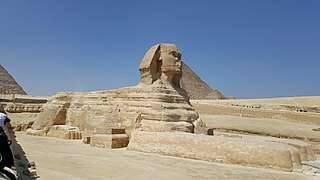 The Great Sphinx of Giza in Egypt
The Great Sphinx of Giza in Egypt.jpg) The lion featured amongst other animals in a picture recovered during Rosselini's expedition to Nubia and Egypt in 1832
The lion featured amongst other animals in a picture recovered during Rosselini's expedition to Nubia and Egypt in 1832_(14592552427).jpg) Illustration of a lion being encountered by a group of people on an expedition from Somaliland to Lake Lamu
Illustration of a lion being encountered by a group of people on an expedition from Somaliland to Lake Lamu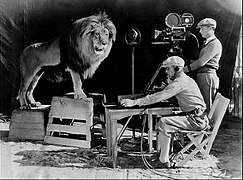 Jackie the MGM lion was from Nubia[167]
Jackie the MGM lion was from Nubia[167]
Regional names
Lion populations in different parts of Africa were referred to by several regional names, including "Katanga lion", "Transvaal lion", "Kalahari lion",[23][58][59] "Southeast African lion", and "Southwest African lion",[89] in Southern Africa, "Masai lion", "Serengeti lion,"[115] "Tsavo lion"[109] and "Uganda lion"[16] in East Africa, and "Cameroon lion"[14] and "North-east Congo lion"[3] in Central Africa.
Gallery
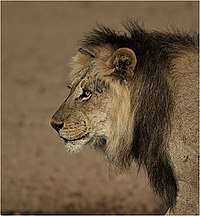 Male at Kgalagadi Transfrontier Park, South Africa
Male at Kgalagadi Transfrontier Park, South Africa_female.jpg) Lioness at Phinda Private Game Reserve
Lioness at Phinda Private Game Reserve
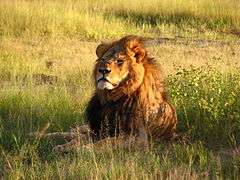
_in_the_lions_enclosure_..._(32499665525).jpg) Female in Hlane Royal National Park, Eswatini
Female in Hlane Royal National Park, Eswatini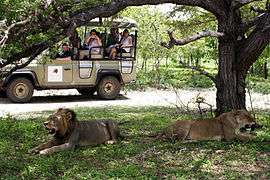 Lion pair at Selous Game Reserve, Tanzania
Lion pair at Selous Game Reserve, Tanzania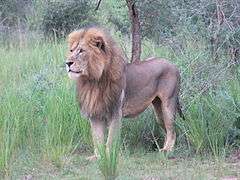 A male in Murchison Falls National Park, Uganda
A male in Murchison Falls National Park, Uganda Lioness at Samburu National Reserve, Kenya
Lioness at Samburu National Reserve, Kenya
See also
- History of lions in Europe
- Wild cats in Africa: African golden cat · Caracal · Serval · African wildcat · Sand cat · Cheetah
- Elsa the lioness
- Born Free
- The Lion King
- African Cats
- Ewaso Lions
- Maasai people
- Wildlife of South Africa
- Bloemfontein lion
- Prehistoric relatives: Upper Pleistocene Eurasian cave lion · Early Middle Pleistocene Eurasian cave lion · American lion
- Physical comparison of tigers and lions
- Tiger versus lion
References
- 1 2 African lion, Species Survival Commission, Cat Specialist Group, retrieved 2017-08-01
- 1 2 3 4 5 6 7 8 9 10 11 12 13 14 15 16 17 Kitchener, A. C.; Breitenmoser-Würsten, C.; Eizirik, E.; Gentry, A.; Werdelin, L.; Wilting, A.; Yamaguchi, N.; Abramov, A. V.; Christiansen, P.; Driscoll, C.; Duckworth, J. W.; Johnson, W.; Luo, S.-J.; Meijaard, E.; O’Donoghue, P.; Sanderson, J.; Seymour, K.; Bruford, M.; Groves, C.; Hoffmann, M.; Nowell, K.; Timmons, Z.; Tobe, S. (2017). "A revised taxonomy of the Felidae: The final report of the Cat Classification Task Force of the IUCN Cat Specialist Group" (PDF). Cat News. Special Issue 11: 71–73. ISSN 1027-2992.
- 1 2 3 4 5 6 7 8 9 10 Barnett, R.; Sinding, M. H.; Vieira, F. G.; Mendoza, M. L.; Bonnet, M.; Araldi, A.; Kienast, I.; Zambarda, A.; Yamaguchi, N.; Henschel, P.; Gilbert, M. T. (2018). "No longer locally extinct? Tracing the origins of a lion (Panthera leo) living in Gabon". Conservation Genetics. 19 (3): 1–8. doi:10.1007/s10592-017-1039-2.
- 1 2 3 4 5 6 7 8 9 10 11 12 13 14 15 16 17 18 19 20 21 22 Bertola, L.D.; Jongbloed, H.; Van Der Gaag, K.J.; De Knijff, P.; Yamaguchi, N.; Hooghiemstra, H.; Bauer, H.; Henschel, P.; White, P.A.; Driscoll, C.A. & Tende, T. (2016). "Phylogeographic patterns in Africa and High Resolution Delineation of genetic clades in the Lion (Panthera leo)". Scientific Reports. 6: 30807. doi:10.1038/srep30807. PMC 4973251. PMID 27488946.
- 1 2 3 Nowell, K.; Jackson, P. (1996). "African lion" (PDF). Wild Cats: Status Survey and Conservation Action Plan. Gland, Switzerland: IUCN/SSC Cat Specialist Group. pp. 17–21. ISBN 978-2-8317-0045-8.
- 1 2 3 Black, S. A.; Fellous, A.; Yamaguchi, N.; Roberts, D. L. (2013). "Examining the Extinction of the Barbary Lion and Its Implications for Felid Conservation". PLOS One. 8 (4): e60174. doi:10.1371/journal.pone.0060174. PMC 3616087. PMID 23573239.
- ↑ Yadav, P. R. (2004). Vanishing And Endangered Species. Discovery Publishing House. pp. 176–78. ISBN 81-7141-776-0. Retrieved 14 December 2010.
- ↑ Burger, Joachim; Hemmer, Helmut (2006). "Urgent call for further breeding of the relic zoo population of the critically endangered Barbary lion (Panthera leo leo Linnaeus 1758)" (PDF). European Journal of Wildlife Research. 52: 54–58. doi:10.1007/s10344-005-0009-z. Archived from the original (PDF) on 2007-07-03. Retrieved 2018-10-02.
- ↑ Black, Simon; Yamaguchi, Nobuyuki; Harland, Adrian; Groombridge, Jim (2010). "Maintaining the genetic health of putative Barbary lions in captivity: an analysis of Moroccan Royal Lions". European Journal of Wildlife Research. 56: 21–31. doi:10.1007/s10344-009-0280-5.
- 1 2 Sunquist, M. E.; Sunquist, F. C. (2009). "Family Felidae (Cats)". In Wilson, Don E.; Russell A. Mittermeier, Russell A.; Sue Ruff; Albert Martínez-Vilalta; Josep del Hoyo; Paolo Cavallini. Handbook of the Mammals of the World. 1: Carnivores. Lynx. p. 137 ff. ISBN 978-84-96553-49-1.
- 1 2 3 4 Macdonald, David Wayne (2006). The Encyclopedia of Mammals. pp. 628–635. ISBN 0-87196-871-1.
- ↑ Angelici, F. M.; Mahama, A. & Rossi, L. (20 July 2015). "The lion in Ghana: its historical and current status" (PDF). Animal Biodiversity and Conservation. 38.2: 151–162. Retrieved 26 February 2016.
- ↑ Gray, J. E. (1843). List of the specimens of Mammalia in the collection of the British Museum. London: Trustees of the British Museum.
- 1 2 3 4 5 6 7 8 Heptner, V. G.; Sludskij, A. A. (1992) [1972]. "Lion". Mlekopitajuščie Sovetskogo Soiuza. Moskva: Vysšaia Škola [Mammals of the Soviet Union. Volume II, Part 2. Carnivora (Hyaenas and Cats)]. Washington DC: Smithsonian Institution and the National Science Foundation. pp. 83–95. ISBN 978-90-04-08876-4.
- ↑ "United Nations Statistics Division- Standard Country and Area Codes Classifications (M49)". un.org.
- 1 2 3 4 5 6 7 8 9 10 11 12 13 14 Hemmer, H. (1974). "Untersuchungen zur Stammesgeschichte der Pantherkatzen (Pantherinae) Teil 3. Zur Artgeschichte des Löwen Panthera (Panthera) leo (Linnaeus, 1758)". Veröffentlichungen der Zoologischen Staatssammlung (in German). 17: 167–280.
- 1 2 3 4 5 6 7 Haas, S.K.; Hayssen, V.; Krausman, P.R. (2005). "Panthera leo" (PDF). Mammalian Species. 762: 1–11. doi:10.1644/1545-1410(2005)762[0001:PL]2.0.CO;2. Archived from the original (PDF) on 28 July 2017.
- 1 2 3 4 5 Allen, J. A. (1924). "Carnivora Collected By The American Museum Congo Expedition". Bulletin of the American Museum of Natural History. 47: 73–281.
- 1 2 "A New, Genetically Distinct Lion Population is Found". News Watch. National Geographic Society. 30 November 2012. Retrieved 13 December 2015.
The Addis Ababa zoo lions have dark manes and small bodies, unlike other African lions. But life in captivity can sometimes influence appearance. A team of researchers, led by the Max Planck Institute for Evolutionary Anthropology in Germany and the University of York in the UK, checked to see if the lions really are different by comparing DNA samples of 15 lions from the zoo to six populations of wild lions. Their genetic analysis revealed that the gene sequence of all fifteen lions were unique and showed little sign of inbreeding. The study was recently published in the European Journal of Wildlife Research.
- 1 2 3 4 5 6 Bruche, S.; Gusset, M.; Lippold, S.; Barnett, R.; Eulenberger, K.; Junhold, J.; Driscoll, C. A.; Hofreiter, M. (2012). "A genetically distinct lion (Panthera leo) population from Ethiopia". European Journal of Wildlife Research. 59 (2): 215–225. doi:10.1007/s10344-012-0668-5.
- 1 2 Lönnberg, E. (1910). "Mammals". In Sjöstedt, Y. Wissenschaftliche Ergebnisse der Schwedischen Zoologischen Expedition nach dem Kilimandjaro, dem Meru und den umgebenden Massaisteppen Deutsch-Ostafrikas 1905–1906. Volume 1. Uppsala: Königlich Schwedische Akademie der Wissenschaften.
- 1 2 3 4 5 6 Allen, G. M. (1939). "A Checklist of African Mammals". Bulletin of the Museum of Comparative Zoology at Harvard College. 83: 1–763.
- 1 2 3 4 Lönnberg, E. (1914). "New and rare mammals from Congo". Revue de Zoologie Africaine (3): 273–278.
- 1 2 3 4 Wood, John George (1865). "Felidæ; or the Cat Tribe". The illustrated natural history. The University of Michigan Libraries. Boradway, Ludgate Hill, New York City: Routledge. p. 147.
- 1 2 3 4 Wood, John George (1865). "Felidæ; or the Cat Tribe". Animal Kingdom. Harvard College Library. Boston: H. A. Brown. p. 147.
- 1 2 3 4 5 6 7 8 9 10 Bauer, H.; Van Der Merwe, S. (2004). "Inventory of free-ranging lions Panthera leo in Africa". Oryx. 38 (1): 26–31. doi:10.1017/S0030605304000055.
- 1 2 3 4 5 6 7 8 9 10 11 12 13 14 Chardonnet, P. (2002). Conservation of African lion (PDF). Paris: International Foundation for the Conservation of Wildlife. Archived from the original (PDF) on 10 November 2013.
- 1 2 3 4 5 6 7 8 9 10 11 12 13 14 15 16 17 18 19 20 21 22 23 24 25 26 27 28 29 30 31 32 33 34 35 36 37 38 39 40 41 42 43 44 45 46 47 48 49 50 51 52 53 54 55 56 57 58 59 60 61 62 63 64 65 66 67 68 69 70 71 72 73 Riggio, J.; Jacobson, A.; Dollar, L.; Bauer, H.; Becker, M.; Dickman, A.; Funston, P.; Groom, R.; Henschel, P.; De Iongh, H.; Lichtenfeld, L.; Pimm, S. (2013). "The size of savannah Africa: a lion's (Panthera leo) view". Biodiversity Conservation. 22 (1): 17–35. doi:10.1007/s10531-012-0381-4.
- 1 2 3 4 Henschel, P.; Bauer, H.; Sogbohoussou, E. & Nowell, K. (2015). "Panthera leo (West Africa subpopulation)". IUCN Red List of Threatened Species. Version 2018-1. International Union for Conservation of Nature.
- ↑ Linnaeus, C. (1758). "Felis Leo". Systema naturae per regna tria naturae: secundum classes, ordines, genera, species, cum characteribus, differentiis, synonymis, locis (in Latin). 1 (10th ed.). Holmiae (Laurentii Salvii). p. 41. Retrieved 8 September 2008.
- ↑ Meyer, J. N. (1826). Dissertatio inauguralis anatomico-medica de genere felium. Doctoral thesis, University of Vienna.
- 1 2 Blainville, H. M. D. de (1843). "F. leo nubicus". Ostéographie ou description iconographique comparée du squelette et du système dentaire des mammifères récents et fossils pour servir de base à la zoologie et la géologie (in French). 2. Paris: J. B. Baillière et Fils. p. 186.
- ↑ Gray, J. E. (1843). List of the specimens of Mammalia in the collection of the British Museum. London: Trustees of the British Museum.
- 1 2 Matschie, P. (1900). "Einige Säugethiere aus dem Hinterlande von Kamerun". Sitzungs-Berichte der Gesellschaft der Naturforschender Freunde zu Berlin. 3: 87–100.
- ↑ Ellerman, J. R.; Morrison-Scott, T. C. S. (1966). Checklist of Palaearctic and Indian mammals 1758 to 1946 (Second ed.). London: British Museum of Natural History. pp. 312–313.
- ↑ West, P. M.; Packer, C. (2013). "Panthera leo Lion". In Kingson, J.; Happold, D.; Butynski, T.; Hoffmann, M.; Happold, M.; Kalina, J. Mammals of Africa. Volume V. A & C Black. p. 149−159. ISBN 978-1-4081-8996-2.
- 1 2 3 4 5 Wozencraft, W.C. (2005). "Panthera leo". In Wilson, D.E.; Reeder, D.M. Mammal Species of the World: A Taxonomic and Geographic Reference (3rd ed.). Johns Hopkins University Press. p. 546. ISBN 978-0-8018-8221-0. OCLC 62265494.
- 1 2 3 4 5 6 7 8 9 10 Bauer, H.; Packer, C.; Funston, P. F.; Henschel, P.; Nowell, K. (2016). "Panthera leo". IUCN Red List of Threatened Species. Version 2017-3. International Union for Conservation of Nature.
- ↑ Barnett, R.; Yamaguchi, N.; Barnes, I.; Cooper, A. (2006). "The origin, current diversity and future conservation of the modern lion (Panthera leo)" (PDF). Proceedings of the Royal Society B: Biological Sciences. 273 (1598): 2119–2125. doi:10.1098/rspb.2006.3555. PMC 1635511. PMID 16901830. Archived from the original (PDF) on 8 August 2007.
- 1 2 3 4 5 Antunes, A.; Troyer, J. L.; Roelke, M. E.; Pecon-Slattery, J.; Packer, C.; Winterbach, C.; Winterbach, H.; Johnson, W. E. (2008). "The Evolutionary Dynamics of the Lion Panthera leo Revealed by Host and Viral Population Genomics". PLOS Genetics. 4 (11): e1000251. doi:10.1371/journal.pgen.1000251. PMC 2572142. PMID 18989457.
- ↑ Mazák, J. H. (2010). "Geographical variation and phylogenetics of modern lions based on craniometric data". Journal of Zoology. 281 (3): 194−209.
- 1 2 3 4 5 Bertola, L. D.; Van Hooft, W. F.; Vrieling, K.; Uit De Weerd, D. R.; York, D. S.; Bauer, H.; Prins, H. H. T.; Funston, P. J.; Udo De Haes, H. A.; Leirs, H.; Van Haeringen, W. A.; Sogbohossou, E.; Tumenta, P. N.; De Iongh, H. H. (2011). "Genetic diversity, evolutionary history and implications for conservation of the lion (Panthera leo) in West and Central Africa" (PDF). Journal of Biogeography. 38 (7): 1356–1367. doi:10.1111/j.1365-2699.2011.02500.x.
- 1 2 Henschel, P.; Coad, L.; Burton, C.; Chataigner, B.; Dunn, A.; MacDonald, D.; Saidu, Y.; Hunter, L. T. B. (2014). Hayward, M., ed. "The Lion in West Africa is Critically Endangered". PLoS ONE. 9 (1): e83500. doi:10.1371/journal.pone.0083500. PMC 3885426. PMID 24421889.
- ↑ Henschel, P.; Azani, D.; Burton, C.; Malanda, G.; Saidu, Y.; Sam, M.; Hunter, L. (2010). "Lion status updates from five range countries in West and Central Africa" (PDF). Cat News. 52: 34–39.
- ↑ Bauer, H.; De Iongh, H.H. (2005). "Lion (Panthera leo) home ranges and livestock conflicts in Waza National Park, Cameroon". African Journal of Ecology. 43 (3): 208−214.
- 1 2 3 4 5 6 7 Mésochina, P.; Mbangwa, O.; Chardonnet, P.; Mosha, R.; Mtui, B.; Drouet, N.; Kissui, B. (2010), "Conservation status of the lion (Panthera leo Linnaeus, 1758) in Tanzania", SCI Foundation, MNRT-WD, TAWISA & IGF Foundation, Paris
- 1 2 3 Croes, B. M.; Funston, P. J.; Rasmussen, G.; Buij, R.; Saleh, A.; Tumenta, P. N.; De Iongh, H. H. (2011). "The impact of trophy hunting on lions (Panthera leo) and other large carnivores in the Bénoué Complex, northern Cameroon". Biological Conservation. 144 (12): 3064−3072.
- 1 2 3 4 Tumenta, P. N.; Kok, J. S.; Van Rijssel, J. C.; Buij, R.; Croes, B. M.; Funston, P. J.; De Iongh, H. H.; Udo de Haes, H. A. (2010). "Threat of rapid extermination of the lion (Panthera leo leo) in Waza National Park, Northern Cameroon". African Journal of Ecology. 48 (4): 888−894.
- 1 2 3 4 "Conservation Strategy for the Lion West and Central Africa", Cat Specialist Group / IUCN, Yaounde, Cameroon, 2006
- 1 2 3 4 5 6 7 8 9 10 Bauer, H.; Chardonnet, P.; Nowell, K. (December 2005), Status and distribution of the lion (Panthera leo) in East and Southern Africa (PDF), Johannesburg, South Africa: East and Southern African lion Conservation Workshop, retrieved 2018-09-03
- 1 2 Barnett, R.; Yamaguchi, N.; Barnes, I.; Cooper, A. (2006). "Lost populations and preserving genetic diversity in the lion Panthera leo: Implications for its ex situ conservation" (PDF). Conservation Genetics. 7 (4): 507–514. doi:10.1007/s10592-005-9062-0. Archived from the original (PDF) on 2006-08-24.
- ↑ Bauer, H.; Chapron, G.; Nowell, K.; Henschel, P.; Funston, P.; Hunter, L. T.; Macdonald, D. W.; Packer, C. (2015). "Lion (Panthera leo) populations are declining rapidly across Africa, except in intensively managed areas". Proceedings of the National Academy of Sciences. 112 (48): 14894–14899.
- 1 2 3 4 5 6 Mazak, V. (1975). "Notes on the Black-maned Lion of the Cape, Panthera leo melanochaita (Ch. H. Smith, 1842) and a Revised List of the Preserved Specimens". Verhandelingen Koninklijke Nederlandse Akademie van Wetenschappen (64): 1–44.
- 1 2 Smith, C.H. (1842). "Black maned lion Leo melanochaitus". In Jardine, W. The Naturalist's Library. Vol. 15 Mammalia. London: Chatto and Windus. p. Plate X, 177.
- 1 2 Noack, T. (1891). "Felis leo". Jahrbuch der Hamburgischen Wissenschaftlichen Anstalten. 9 (1): 120.
- 1 2 3 4 Neumann, O. (1900). "Die von mir in den Jahren 1892–95 in Ost- und Central-Afrika, speciell in den Massai-Ländern und den Ländern am Victoria Nyansa gesammelten und beobachteten Säugethiere". Zoologische Jahrbücher. Abtheilung für Systematik, Geographie und Biologie der Thiere. 13 (VI): 529–562.
- 1 2 3 Heller, E. (1914). "New races of carnivores and baboons from equatorial Africa and Abyssinia". Smithsonian Miscellaneous Collections. 61 (19): 1–12.
- 1 2 3 Roberts, A. (1929). "New forms of African mammals". Annals of the Transvaal Museum. 21 (13): 82–121.
- 1 2 Roberts, A. (1948). "Descriptions of some new subspecies of mammals". Annals of the Transvaal Museum. 21 (1): 63–69.
- ↑ Zukowsky, L. (1964). "Eine neue Löwenrasse als weiterer Beleg für die Verzwergung der Wirbeltierfauna des afrikanischen Osthorns". Milu, Wissenschaftliche und Kulturelle Mitteilungen aus dem Tierpark Berlin (1): 269–273.
- 1 2 Lundholm, B. (1952). "A skull of a Cape lioness (Felis leo melanochaitus H. Smith". Annals of the Transvaal Museum (32): 21–24.
- ↑ Stevenson-Hamilton, J. (1954). "Specimen of the extinct Cape lion". African Wildlife (8): 187–189.
- ↑ Pocock, R. I. (1930). "The lions of Asia". Journal of the Bombay Natural Historical Society. 34: 638–665.
- ↑ Ellerman, J. R.; Morrison-Scott, T. C. S. (1966). "Subgenus Leo Oken, 1816, (Brehm, 1829)". Checklist of Palaearctic and Indian Mammals 1758 to 1946 (Second ed.). London: British Museum (Natural History). p. 319.
- ↑ Meester, J.; Setzer, H. W. (1977). The mammals of Africa. An identification manual. Washington, DC: Smithsonian Institution Press.
- 1 2 Yamaguchi, N. (2000). "The Barbary lion and the Cape lion: their phylogenetic places and conservation" (PDF). African Lion Working Group News. 1: 9–11.
- ↑ O’Brien, S. J.; Martenson, J. S.; Packer, C.; Herbst, L.; de Vos, V.; Joslin, P.; Ott-Joslin, J.; Wildt, D. E. & Bush, M. (1987). "Biochemical genetic variation in geographic isolates of African and Asiatic lions" (PDF). National Geographic Research. 3 (1): 114–124. Archived from the original (PDF) on 2013-05-02.
- ↑ Mazák, J. H. (2010). "Geographical variation and phylogenetics of modern lions based on craniometric data". Journal of Zoology. 281 (3): 194−209.
- ↑ Dubach, J.; Patterson, B. D.; Briggs, M. B.; Venzke, K.; Flamand, J.; Stander, P.; Scheepers, L.; Kays, R. W. (2005). "Molecular genetic variation across the southern and eastern geographic ranges of the African lion, Panthera leo". Conservation Genetics. 6 (1): 15–24. doi:10.1007/s10592-004-7729-6.
- 1 2 Fagotto, F. (1985). "Larger animals of Somalia in 1984". Environmental Conservation. 12 (3): 260−264.
- 1 2 Dolrenry S.; Hazzah L.; Frank L. G. (2016). "Conservation and monitoring of a persecuted African lion population by Maasai warriors". Conservation Biology. 30 (3): 467–475. doi:10.1111/cobi.12703. PMID 27111059.
- ↑ Treves, A.; Plumptre A. J.; Hunter L. T.; Ziwa J. (2009). "Identifying a potential lion Panthera leo stronghold in Queen Elizabeth National Park, Uganda, and Parc National Des Virunga, Democratic Republic of Congo". Oryx. 43 (1): 60–66. doi:10.1017/s003060530700124x.
- ↑ Omoya, E. O.; Mudumba, T.; Buckland, S. T.; Mulondo, P. & Plumptre, A. J. (2014). "Estimating population sizes of lions Panthera leo and spotted hyaenas Crocuta crocuta in Uganda's savannah parks, using lure count methods" (PDF). Oryx. 48 (3): 394–401.
- 1 2 Frank, L.; Maclennan, S.; Hazzah, L.; Hill, T.; Bonham, R. (2006), "Lion Killing in the Amboseli-Tsavo Ecosystem, 2001–2006, and its Implications for Kenya's Lion Population" (PDF), Living with Lions, Nairobi, Kenya 9
- ↑ Hayward, M. W.; Adendorff, J.; O’Brien, J.; Sholto-Douglas, A.; Bissett, C.; Moolman, L. C.; Bean, P.; Fogarty, A.; Howarth, D.; Slater, R.; Kerley, G. I. (2007). "Practical considerations for the reintroduction of large, terrestrial, mammalian predators based on reintroductions to South Africa's Eastern Cape Province". The Open Conservation Biology Journal. 1 (1): 1–11.
- ↑ Cushman, S. A.; Elliot, N. B.; Bauer, D.; Kesch, K.; Bothwell, H.; Flyman, M.; Mtare, G.; Macdonald, D. W.; Loveridge, A. J. (2018). "Prioritizing core areas, corridors and conflict hotspots for lion conservation in southern Africa". PLOS One. 13 (7): e0196213.
- ↑ Henschel, P. H.; Azani, D. E.; Burton, C. O.; Malanda, G.; Saidu, Y. O.; Sam, M. O.; Hunter, L. U. (2010). "Lion status updates from five range countries in West and Central Africa". Cat News. 52: 34–39.
- ↑ Hedwig, D.; Kienast, I.; Bonnet, M.; Curran, B. K.; Courage, A.; Boesch, C.; Kühl, H. S.; King, T. (2017). "A camera trap assessment of the forest mammal community within the transitional savannah‐forest mosaic of the Batéké Plateau National Park, Gabon". African Journal of Ecology. doi:10.1111/aje.12497.
- ↑ Henschel, P.; Malanda, G. A.; Hunter, L. (2014). "The status of savanna carnivores in the Odzala-Kokoua National Park, northern Republic of Congo". Journal of Mammalogy. 95 (4): 882−892. Bibcode:2007JMamm..88..275L. doi:10.1644/13-mamm-a-306. ISSN 0022-2372.

- 1 2 3 4 5 6 Pease, A. E. (1909-10-16). The Book of the Lion. Ravenio Books.
- 1 2 Jonathan Kingdon; David Happold; Thomas Butynski; Michael Hoffmann; Meredith Happold; Jan Kalina (2013-05-23). Mammals of Africa. 1–6. A & C Black. p. 150. ISBN 978-1-4081-8996-2.
- ↑ "List of members", Eighth Annual Report, The New York Zoological Society, 1903, p. 32
- ↑ "Summary of membership", Nineteenth Annual Report, The New York Zoological Society, 1914, p. 36
- ↑ Barnett, R.; Shapiro, B.; Barnes, I. A. N.; Ho, S. Y. W.; Burger, J.; Yamaguchi, N.; Higham, T. F. G.; Wheeler, H. T.; Rosendahl, W.; Sher, A. V.; Sotnikova, M.; Kuznetsova, T.; Baryshnikov, G. F.; Martin, L. D.; Harington, C. R.; Burns, J. A.; Cooper, A. (2009). "Phylogeography of lions (Panthera leo ssp.) reveals three distinct taxa and a late Pleistocene reduction in genetic diversity". Molecular Ecology. 18 (8): 1668–1677. doi:10.1111/j.1365-294X.2009.04134.x. PMID 19302360.
- 1 2 "Lions rediscovered in Ethiopia's Alatash National Park". BBC News. 2016. Retrieved 1 February 2016.
- 1 2 Howard, B. C. (2016). "Once Thought Extinct, 'Lost' Group of Lions Discovered in Africa". National Geographic. Retrieved 2016-02-07.
- 1 2 Wong, S. (2016). "Hidden population of up to 200 lions found in remote Ethiopia". New Scientist. Retrieved 2 February 2016.
- ↑ Yirga, G.; Gebresenbet, F.; Deckers, J.; Bauer, H. (2014). "Status of Lion (Panthera leo) and Spotted Hyena (Crocuta crocuta) in Nechisar National Park, Ethiopia". Momona Ethiopian Journal of Science. 6 (2): 127–137.
- 1 2 Jackson, D. (2010). "Introduction". Lion. London: Reaktion Books. pp. 1–21. ISBN 978-1861897350.
- ↑ Pocock, R. I. (1939). "Panthera leo". The Fauna of British India, including Ceylon and Burma. Mammalia. – Volume 1. London: Taylor and Francis Ltd. pp. 212–222.
- ↑ Funaioli & Simonetta 1966, pp. 260−264.
- ↑ Treves, A.; Naughton-Treves, L. (1999). "Risk and opportunity for humans coexisting with large carnivores". Journal of Human Evolution. 36 (3): 275−282.
- ↑ Smithers, R.H.N. (1971). The Mammals of Botswana. Pretoria: University of Pretoria.
- ↑ Stander, P.E. (1990). "A suggested management strategy for stock-raiding lions in Namibia". South African Journal of Wildlife Research. 20 (2): 37−43.
- 1 2 3 4 5 Guggisberg, C. A. W. (1975). "Lion Panthera leo (Linnaeus, 1758)". Wild Cats of the World. New York: Taplinger Publishing. pp. 138–179. ISBN 978-0-8008-8324-9.
- ↑ Rautenbach, I. L. (1978). The Mammals of the Transvaal. Pietermaritzburg: University of Natal.
- ↑ Treves, A.; Plumptre, A. J.; Hunter, L. T. B.; Ziwa, J. (2009). "Identifying a potential lion Panthera leo stronghold in Queen Elizabeth National Park, Uganda, and Parc National des Virunga, Democratic Republic of Congo". Oryx. 43: 60−66.
- ↑ Mudumba, T.; Mulondo, P.; Okot, E.; Nsubuga, M.; Plumptre, A. (2010), "National census of lions and hyaenas in Uganda", Uganda Wildlife Authority, Uganda
- 1 2 3 4 Chardonnet, P.; Mésochina, P.; Bento, C.; Conjo, D.; Begg, C. l. (2009), Conservation status of the lion (Panthera leo Linnaeus, 1758) in Mozambique, Maputo, Mozambique
- ↑ Pease, A. E. (1913). The Book of the Lion. London: John Murray.
- 1 2 Mazák, V. (1970). "The Barbary lion, Panthera leo leo (Linnaeus, 1758); some systematic notes, and an interim list of the specimens preserved in European museums". Zeitschrift für Säugetierkunde. 35: 34−45.
- ↑ Smithers, R. H. N. (1971). The Mammals of Botswana. Pretoria: University of Pretoria.
- 1 2 West, P. M.; Packer, C. (2002). "Sexual Selection, Temperature, and the Lion's Mane". Science. 297 (5585): 1339–1943. Bibcode:2002Sci...297.1339W. doi:10.1126/science.1073257. PMID 12193785.
- ↑ Smuts, G. L.; Robinson, G. A.; Whyte, I. J. (1980). "Comparative growth of wild male and female lions (Panthera leo)". Journal of Zoology. 190 (3): 365–373. Bibcode:2010JZoo..281..263G. doi:10.1111/j.1469-7998.1980.tb01433.x.
- 1 2 3 Turner, J. A.; Vasicek, C. A.; Somers, M. J. (2015). "Effects of a colour variant on hunting ability: the white lion in South Africa". Open Science Repository Biology: e45011830.
- 1 2 Guggisberg, Charles Albert Walter (1963). Simba: The Life of the Lion. Philadelphia, PA: Chilton Books. ASIN B000OKBJQ0.
- ↑ Gnoske T. P.; Celesia, G. G.; Kerbis, Peterhans J. C. (2006). "Dissociation between mane development and sexual maturity in lions (Panthera leo): solution to the Tsavo riddle?". Journal of Zoology. 270 (4): 551–560. Bibcode:2010JZoo..281..263G. doi:10.1111/j.1469-7998.2006.00200.x.
- ↑ Call the Hair Club for Lions. The Field Museum.
- 1 2 Borzo, G. (2002). "Unique social system found in famous Tsavo lions". EurekAlert.
- ↑ Nagel, D.; Hilsberg, S.; Benesch, A.; Scholtz, J. (2003). "Functional morphology and fur patterns in recent and fossil Panthera species". Scripta Geologica. 126: 227–239.
- ↑ McBride, C. (1977). The White Lions of Timbavati. Johannesburg: E. Stanton. ISBN 978-0-949997-32-6.
- ↑ Tucker, L. (2003). Mystery of the White Lions—Children of the Sun God. Mapumalanga: Npenvu Press. ISBN 978-0-620-31409-1.
- ↑ Wood, G. L. (1983). The Guinness Book of Animal Facts and Feats. Sterling Publishing. ISBN 978-0-85112-235-9.
- 1 2 Brakefield, T. (1993). Big Cats: Kingdom of Might. Voyageur Press. p. 44. ISBN 978-0-89658-329-0.
- 1 2 3 4 Schaller, George B. (1972). The Serengeti lion: A study of predator–prey relations. Chicago: University of Chicago Press. ISBN 978-0-226-73639-6.
- ↑ Milius, S. (2002). "Biology: Maneless lions live one guy per pride". Society for Science & the Public. 161 (16): 253. doi:10.1002/scin.5591611614.
- 1 2 Hanby, J. P., and Bygott, J. D. (1979). "Population changes in lions and other predators". In Sinclair, A. R. E.; Norton-Griffiths, M. Serengeti: dynamics of an ecosystem. Chicago: The University of Chicago Press. pp. 249–262.
- ↑ Bertram, B. C. R. (1973). "Lion population regulation". East Africa Wildlife Journal. 11 (3−4): 215−225. doi:10.1111/j.1365-2028.1973.tb00088.x.
- ↑ Borrego, N.; Ozgul, A.; Slotow, R.; Packer, C. (2018). "Lion population dynamics: do nomadic males matter?". Behavioral Ecology. 29 (3): 660–666. doi:10.1093/beheco/ary018.
- ↑ Elliot, N. B.; Cushman, S. A.; Macdonald, D. W.; Loveridge, A. J. (2014). "The devil is in the dispersers: predictions of landscape connectivity change with demography". Journal of Applied Ecology. 51 (5): 1169–1178.
- 1 2 Hayward, M. W.; Kerley, G. I. H. (2005). "Prey preferences of the lion (Panthera leo)" (PDF). Journal of Zoology. 267 (3): 309–322. Bibcode:2010JZoo..281..263G. CiteSeerX 10.1.1.611.8271. doi:10.1017/S0952836905007508.
- ↑ Pienaar, U. de V. (1969). "Predator–prey relationships among the larger mammals of the Kruger National Park". Koedoe. 12 (1). doi:10.4102/koedoe.v12i1.753.
- ↑ Hayward, M. W. (2006). "Prey preferences of the spotted hyaena (Crocuta crocuta) and degree of dietary overlap with the lion (Panthera leo)" (PDF). Journal of Zoology. 270 (4): 606–614. doi:10.1111/j.1469-7998.2006.00183.x.
- ↑ Power, R. J.; Compion, R. X. S. (2009). "Lion predation on elephants in the Savuti, Chobe National Park, Botswana". African Zoology. 44 (1): 36–44. doi:10.3377/004.044.0104.
- ↑ Sunquist, Fiona; Sunquist, Mel (2014-10-02). "Bibliography". The Wild Cat Book: Everything You Ever Wanted to Know about Cats. China: University of Chicago Press. p. 8. ISBN 978-0-2261-4576-1.
- ↑ Main, Douglas (2013-11-26). "Photos: The Biggest Lions on Earth". Live Science. Retrieved 2018-04-18.
- ↑ "Lions of the Okavango". Siyabona Africa. 2017.
- ↑ Sogbohossou, E. A.; Bauer, H.; Loveridge, A.; Funston, P. J.; De Snoo, G. R.; Sinsin, B.; De Iongh, H. H. (2014). "Social structure of lions (Panthera leo) is affected by management in Pendjari Biosphere Reserve, Benin". PLOS One. 9 (1): e84674.
- 1 2 Heller, E. (1914). "New races of carnivores and baboons from equatorial Africa and Abyssinia". Smithsonian Miscellaneous Collections. 61 (19): 1–12.
- ↑ Jeal, Tim (2013). Livingstone: Revised and Expanded Edition. Yale University Press. p. 59.
- ↑ Kerbis Peterhans, J.C.; Gnoske, T.P. (2001). "The Science of 'Man-Eating*' Among Lions Panthera leo With a Reconstruction of the Natural History of the 'Man-Eaters of Tsavo'". Journal of East African Natural History. 90 (1): 1–40. doi:10.2982/0012-8317(2001)90[1:TSOMAL]2.0.CO;2.
- ↑ "Field Museum uncovers evidence behind man-eating; revises legend of its infamous man-eating lions" (Press release). The Field Museum. 2003.
- ↑ Patterson,, John H. (1907). The man-eaters of Tsavo and other East African adventures. London: Macmillan and Co.
- ↑ Rushby, George G. (1965). No More the Tusker. London: W. H. Allen.
- ↑ "South African lions eat 'poacher', leaving just his head". The BBC. 2018-02-14. Retrieved 2018-02-25.
- ↑ Haden, A. (2018-02-12). "Suspected poacher mauled to death by lions close to Kruger National Park". The South African. Retrieved 2018-02-25.
- ↑ Torchia, C. (2018-02-28). "Lion kills woman at refuge of South African 'lion whisperer'". The Washington Post. Retrieved 2018-02-28.
- ↑ Feingold, S. (2018-03-02). "Lion mauls woman to death at popular South African wildlife sanctuary". CNN. Retrieved 2018-03-02.
- ↑ "Lions eat 'rhino poachers' on South African game reserve". BBC. 2018-07-05. Retrieved 2018-07-19.
- ↑ "Suspected rhino poachers killed by lions in South Africa". Associated Press. Ottawa Citizen. 2018-07-06. Retrieved 2018-07-19.
- ↑ Williams, V. L.; Loveridge, A. J.; Newton, D. J.; Macdonald, D. W. (2017). "A roaring trade? The legal trade in Panthera leo bones from Africa to East-Southeast Asia". PLOS One. 12 (10): e0185996. Bibcode:2017PLoSO..1285996W. doi:10.1371/journal.pone.0185996. PMC 5655489. PMID 29065143.
- ↑ Schroeder, R. A. (2018). "Moving Targets: The 'Canned'Hunting of Captive-Bred Lions in South Africa". African Studies Review. 61 (1): 8–32.
- ↑ "'Herdsmen' poison lions, vultures — but not in Nigeria". The Cable. 2018-02-17. Retrieved 2018-02-24.
- ↑ Kamoga, J. (2018). "East African lions dying of poisoning". The Observer. Retrieved 2018-02-24.
- ↑ Winter, S. (2018-02-16). "Lion MASSACRE as six big cats die after eating 'poison'". The Express. Retrieved 2018-02-24.
- ↑ "Zimbabwe's 'iconic' lion Cecil killed by hunter". BBC News. 27 July 2015. Archived from the original on 28 July 2015. Retrieved 3 August 2015.
- ↑ "Xanda, son of Cecil the lion, killed by hunter in Zimbabwe". BBC News. 20 July 2017. Retrieved 20 July 2017.
- ↑ Midlane, N. (2013). The conservation status and dynamics of a protected African lion Panthera leo population in Kafue National Park, Zambia. Cape Town: University of Cape Town.
- ↑ Williams, V. L.; Loveridge, A. J.; Newton, D. J.; Macdonald, D. W. (2017). "Questionnaire survey of the pan-African trade in lion body parts". PLOS One. 12 (10): e0187060. doi:10.1371/journal.pone.0187060. PMC 5658145. PMID 29073202.
- ↑ Funaioli & Simonetta 1966, pp. 285–347.
- ↑ Amir, O. G. (2006). "5.2.2. Lion". Wildlife trade in Somalia. Report to the IUCN/SSC Antelope Specialist Group (PDF). Darmstadt, Germany. pp. 14−15.
- ↑ Ferreira, S. M.; Govender, D.; Herbst, M. (2013). "Conservation implications of Kalahari lion population dynamics". African Journal of Ecology. 51 (2): 176–179.
- ↑ The Kruger Nationalpark Map. Honeyguide Publications CC. South Africa 2004.
- ↑ Smith, D. (2015). "Lions to be reintroduced to Rwanda after 15-year absence following genocide". The Guardian.
- ↑ Cat Specialist Group (2006). Conservation Strategy for the Lion West and Central Africa. IUCN, Yaounde, Cameroon.
- ↑ Tefera, M. (2003). "Phenotypic and reproductive characteristics of lions (Panthera leo) at Addis Ababa Zoo". Biodiversity & Conservation. 12 (8): 1629–1639. doi:10.1023/A:1023641629538.
- ↑ "South Africa: Lion Cubs Thought to Be Cape Lions". AP Archive, of the Associated Press. 8 November 2000. (with 2-minute video of cubs at zoo with John Spence, 3 sound-bites, and 15 photos)
- ↑ "'Extinct' lions (Cape lion) surface in Siberia". The BBC. 2000-11-05. Retrieved 2012-12-31.
- 1 2 Lynch, P. A. (2004). African Mythology A to Z. Infobase Publishing. p. 63. ISBN 978-0-8160-4892-2.
- ↑ Hogarth, C.; Butler, N. (2004). "Animal Symbolism (Africa)". In Walter, M. N. Shamanism: An Encyclopedia of World Beliefs, Practices, and Culture, Volume 1. pp. 3–6. ISBN 978-1-57607-645-3.
- ↑ "Cameroon wins Africa Cup of Nations". Daily Nation. Retrieved 2017-02-09.
- ↑ Hogarth, C.; Butler, N. (2004). "Animal Symbolism (Africa)". In Walter, M. N. Shamanism: An Encyclopedia of World Beliefs, Practices, and Culture, Volume 1. pp. 3–6. ISBN 978-1-57607-645-3.
- ↑ Zivie-Coche, Christiane (2002). Sphinx: History of a Monument. Cornell University Press. pp. 99–100. ISBN 978-0-8014-3962-9.
- ↑ Cosgrove-Mather, Bootie (2004-01-14). "First lion mummy found in tomb near King Tut". AP. CBS News. Retrieved 2018-06-13.
- ↑ Clammer, P. (2005). Sudan. Bradt Travel Guides. pp. 6–261. ISBN 978-1-84162-114-2.
- ↑ "TV ACRES: Advertising Mascots – Animals – Leo the MGM Lion (MGM Studios)". TV Acres. Archived from the original on 2012-12-05.
- 1 2 Joseph, Albright (2018-06-13). "Original MGM lion rests in N.J. & other historical tidbits". Newjersey.com. Retrieved 2018-06-13.
- ↑ "Lion cubs gifted to Erdoğan by Sudan meet zoo visitors". Gaziantep: Hurriyet Daily News. 2018-01-13.
Further reading
- The Penny Cyclopædia of the Society for the Diffusion of Useful Knowledge. 14. Charles Knight and Co. 1846-01-09. Retrieved 2014-08-28.
- Charles Knight, ed. (1867). The English Cyclopaedia. Retrieved 2014-08-28.
- Beolens, B.; Watkins, M.; Grayson, M. (2009-10-07). The Eponym Dictionary of Mammals. Baltimore: Johns Hopkins University Press. p. 110. ISBN 978-0-8018-9533-3.
- Funaioli, U; Simonetta, A. M. (1966). "The Mammalian Fauna of the Somali Republic: Status and Conservation Problems". The Mammalian Fauna of the Somali Republic: Status and Conservation Problems. 1 (The Mammalian Fauna of the Somali Republic: Status and Conservation Problems). doi:10.1080/03749444.1966.10736746 (inactive 2018-09-27). Retrieved 19 September 2018.
- Kays, Roland W.; Patterson, Bruce D. (2002). "Mane variation in African lions and its social correlates". Canadian Journal of Zoology. 80 (3): 471–478. doi:10.1139/z02-024. ISSN 0008-4301.
- Schofield, A. (2013). White Lion: Back to the Wild. Pennsauken: BookBaby. ISBN 978-0620570053.
- Selous, F. C. (2011). "XXV". Travel and Adventure in South-East Africa. New York: Cambridge University Press. p. 445. ISBN 978-1108031165.
External links
| Wikimedia Commons has media related to Panthera leo. |
| Wikimedia Commons has media related to Lions of Southern Africa. |
| Wikimedia Commons has media related to Lions of Southeast Africa. |
| Wikimedia Commons has media related to Lions of West Africa. |
| Wikimedia Commons has media related to Lions of North Africa. |
- African lion
- First film ever about newly discovered lions in montane rainforests of Ethiopia
- Black-maned lion at Bale Mountains National Park (YouTube)
- Panthera leo abyssinica (in the Spanish language)
- Hunting lion in Nuerland
- "Nubian Lion" by Rembrandt Bugatti
- Ancient Egyptian Bestiary: Lions
- Photos of West African lions at Pendjari National Park at flickr
- Wildlife extra: Lions from west and central Africa have more in common with Asiatic lion
- ROCAL West and Central African lion conservation network
- BBC News: Lions 'facing extinction in West Africa'
- Is this one of Central Africa's last lions? (2015)
- Take two: Gabon's lone lion makes another on-camera appearance (2016)
- The Rare Central African Lion - أسود حديقة الدندر فيديو فبراير 2017 (in Dinder National Park, YouTube)
- Draw between a lion and gorilla in a Central African primeval forest, late 19th century
- $0.5m funding to stop the decline in the population of African lions
- What Will It Take to Save the East African Lion from Extinction? Hunting or Herding?
- Lions in East Africa
- East African lion shot by Theodore Roosevelt
- Two marauding lions at Issuna, Tanzania
- Giant Lions Once Prowled East Africa, 200,000-Year-Old Skull Reveals
- Kali the Masai lion
- Notch the Masai lion
- BBC Earth: Lions take down an adult elephant
- The Savuti Lions of the Chobe National Park
- Holding the line for lions in Mozambique (including in Gorongosa National Park)
- A Zambian lion stirs
- Nakawa and Lady Liuwa the Zambian lions
- Recovering population of Zimbabwean African lions show low genetic diversity
- Shamba the South African lion
- Angola lion
- What Happened to Angola’s 1,000 Lions?
- Death of a lion that traveled almost 1,300 km (810 mi) between Angola and Namibia
- Kebbel the Namibian lion at Sesfontein Conservancy
- Lobengula the South African guardian lion
- iNaturalist: Southern Lion (Panthera leo ssp. melanochaita)
- Known for escapes, South African lion becomes a father
